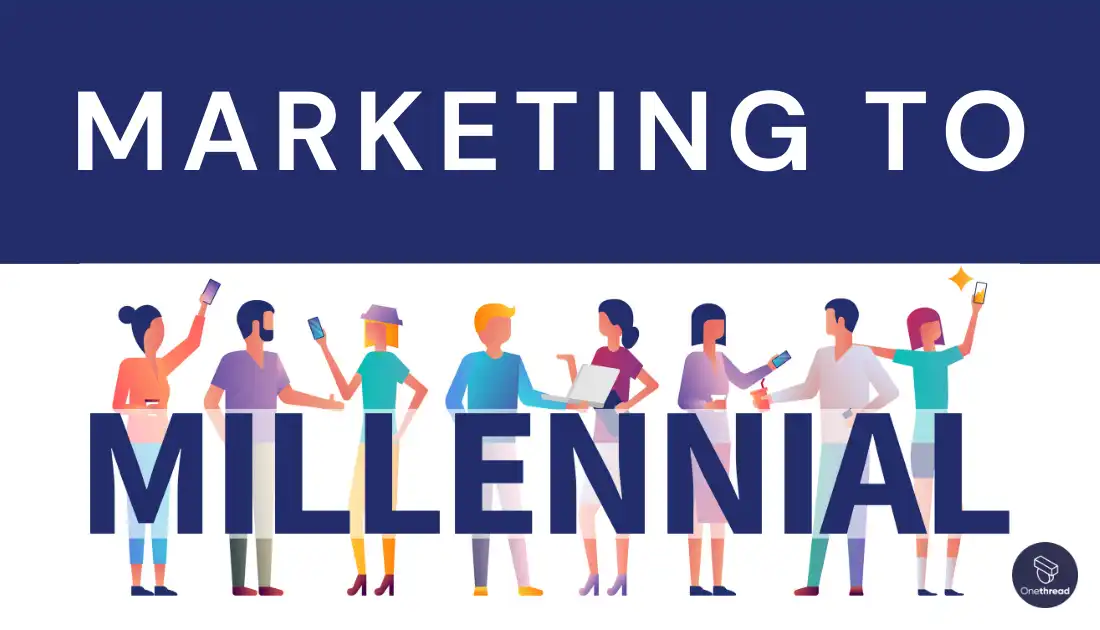If you’re finding it tough to connect with the millennial audience, you’re certainly not alone. But understanding this challenge is the first step to overcoming it.
Millennials, with their impressive number of 92 million in the U.S. alone, aren’t just another demographic tick box. They’re a dynamic force shaping the consumer landscape.

Their purchasing capacity, outshining established groups like the baby boomers and the emerging Gen Z, is on an upward trajectory. As many of them are now stepping into their peak earning and spending years, their influence is undeniable.
It’s clear: for anyone in marketing, tapping into the millennial mindset isn’t just beneficial—it’s essential. Knowing what fuels their choices can design campaigns that genuinely speak to them.
Today, we’ll explore the challenges of marketing to Millennials, shedding light on their preferences, and pinpointing the most effective channels to reach them.
Let’s get started, shall we?
Understanding The Millennial Mindset
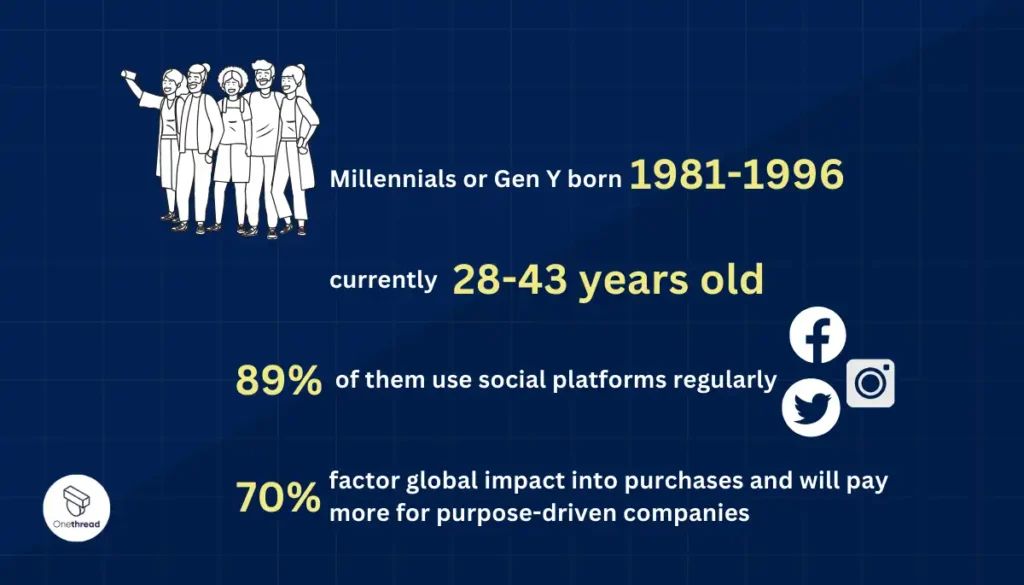

Millennials or Gen Y were born 1981-1996, making them currently 28-43 years old. Having grown up immersed in technology, they rely heavily on mobile devices and social media over traditional media. 89% use social platforms regularly to interact with brands, friends, etc.
Other defining traits are valuing diversity, wanting brands that reflect ethical values like sustainability, and prioritizing convenient services over possessions.
Specifically, 70% factor global impact into purchases and will pay more for purpose-driven companies. Convenience is also prized – seamless digital experiences with instant checkout/BNPL facilitate buying. Millennials have high brand awareness with less loyalty, necessitating excellent service and personalized marketing.
Whether you offer kitchen supplies and tools or web development services, you must facilitate a remarkable buying experience.
Ultimately companies succeeding with this generation show authenticity around social causes while offering customized digital engagement catering to their on-demand lifestyles.
Who Are Millennials?
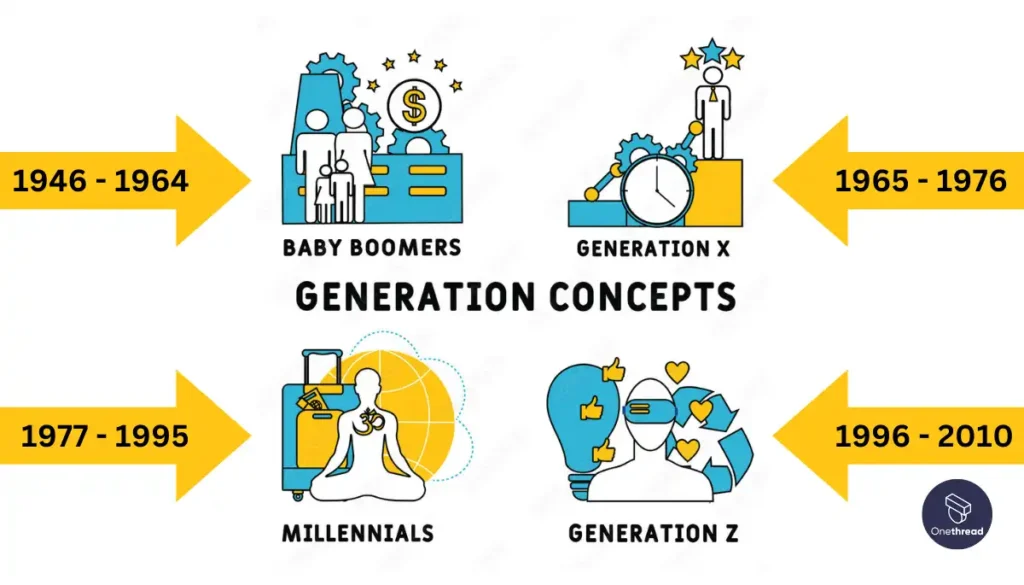

Millennials are the group of people or generation born between 1981 and 1996, according to the Pew Research Center. This generation is also known as “Generation Y” or “Gen Y”. So, the oldest millennials right now are 43 years old and the youngest millennials are 28 years old as of 2024.
If we look back, there was this period called the “baby boom” from 1946 to 1964 and Generation X from 1965 to 1980. Fast forward a bit, and the next significant group to come along was the Millennials.
| Generation | Born | Age at 2023 | Age at 2024 | Age at 2025 |
| Baby Boomers | 1946-1964 | 59-77 | 60-78 | 61-79 |
| Generation X | 1965-1980 | 43-58 | 44-59 | 45-60 |
| Millennials | 1981-1996 | 27-42 | 28-43 | 29-44 |
| Generation Z | 1997-2012 | 11-26 | 12-27 | 13-28 |
The name “Millennial” became popular because many from this group were becoming adults right around the year 2000. But not everyone goes around calling themselves a “Millennial” or “Gen Y”, even if they fit the age bracket.
So, what sets them apart? They grew up with technology. It’s second nature to them, unlike some earlier generations. But this tech familiarity also means they’re pretty sharp when it comes to marketing. They value genuine brands that care about society.
You get the idea that it’s not all about the age, right? There are more factors that make Generation Y a lucrative market. So, let’s start with their demographic.
Millennial Demographic
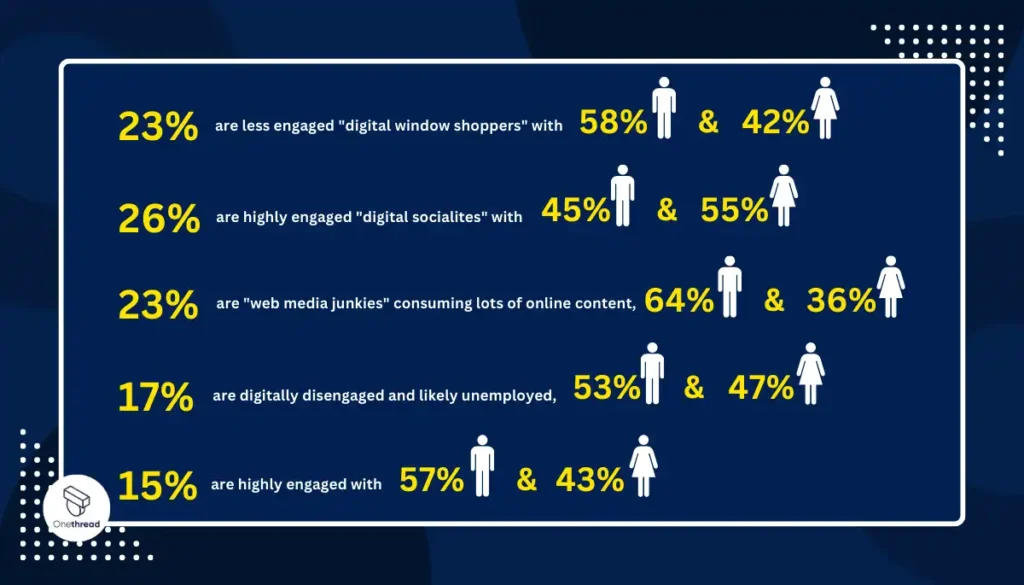

The American millennial generation can be categorized into 5 groups based on their interaction with the internet.
- 23% are less engaged “digital window shoppers” with 58% male and 42% female.
- 26% are highly engaged “digital socialites” with 55% female and 45% male.
- 23% are “web media junkies” consuming lots of online content, 64% male and 36% female.
- 17% are digitally disengaged and likely unemployed, 53% male and 47% female.
- The final 15% are highly engaged with 57% male and 43% female.
As you can see, millennials not only consume media differently than other generations but also differ within theirs. Time to find out their media consumption behavior in detail.
Key Characteristics of Millennials
Millennials are a diverse generation embracing differences with global mindsets from traveling that prioritize inclusion and diversity. Their openness comes from varied backgrounds and immersion in other cultures, leading them to champion tolerance across race, religion, and orientation.
This worldview also influences buying choices – convenience is highly prized, making millennials willing to pay more for services maximizing time, like subscription models.
Additionally, millennials tend to favor muted, neutral tones like shades of gray, blush, and millennial pink. Grey reminds them of concrete and progressive cities aligned with their modern sensibilities. Shades like Cloud Grey also enable self-expression of individuality across fluid identities.
Millennials are attracted to colors perceivable as fresh and boundary-breaking. These adaptive muted hues align with socially conscious generational values as well.
Furthermore, brands recognized as socially responsible also align with millennial priorities around supporting ethical practices, sustainability, equality, and justice. Causes benefiting environmentalism and inclusion likewise win favor.
Demonstrating shared principles including embracing diversity allows companies to boost their image with a generation prioritizing purpose over just convenience.
How Do Millennials Consume Media?
Millennials are the most tech-savvy generation and rely heavily on mobile devices over traditional media. 85% own smartphones, 78% own laptops, and 50% own tablets.
Here’s how they differ in device ownership compared to other contemporary generations-
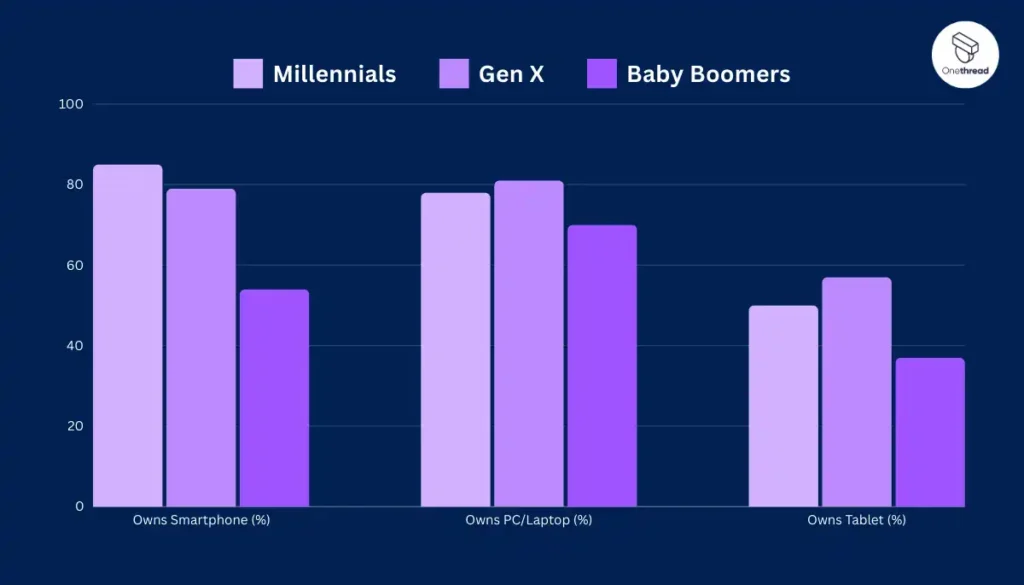

| Generations | Owns Smartphone (%) | Owns PC/Laptop (%) | Owns Tablet (%) |
| Millennials | 85 | 78 | 50 |
| Gen X | 79 | 81 | 57 |
| Baby Boomers | 54 | 70 | 37 |
They spend little time reading print newspapers and magazines or listening to the radio. Only 31-35% consume magazine content and 20-48% read newspaper content on digital devices. Millennials spend the least amount of time watching TV averaging 2.4 hours daily.
In contrast to other generations, the following is how they consume media:
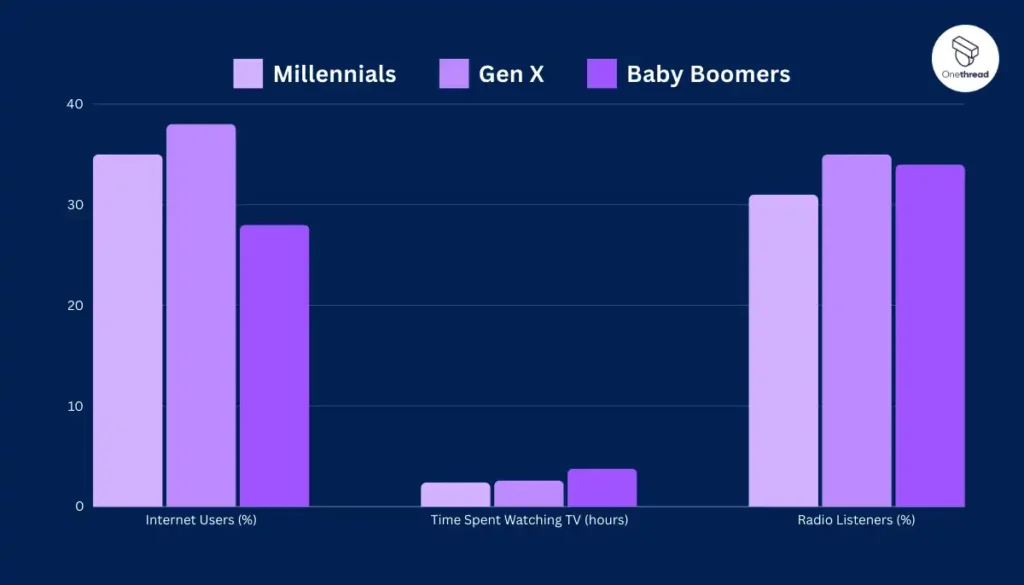

| Generations | Internet Users (%) | Time Spent Watching TV (hours) | Radio Listeners (%) |
| Millennials | 35 | 2.4 | 31 |
| Gen X | 38 | 2.61 | 35 |
| Baby Boomers | 28 | 3.78 | 34 |
However, 89% use social media regularly, far more than older generations, and heavily rely on it to interact with brands, discover products, and follow their favorite companies as follows-
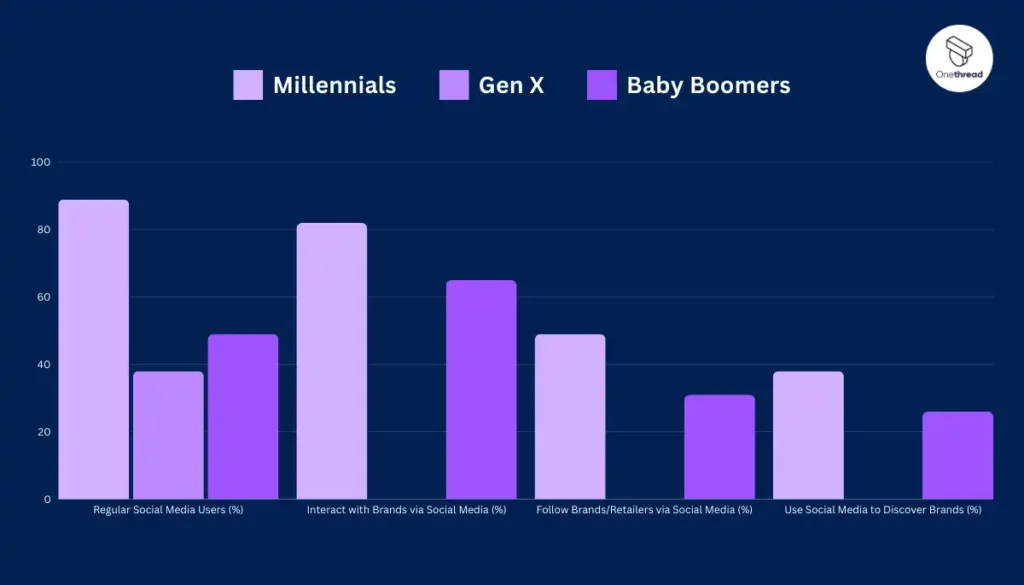

| Generations | Regular Social Media Users (%) | Interact with Brands via Social Media (%) | Follow Brands/Retailers via Social Media (%) | Use Social Media to Discover Brands (%) |
| Millennials | 89 | 82 | 49 | 38 |
| Gen X | 82 | 65 (collective) | 31 (collective) | 26 (collective) |
| Senior Americans | 49 |
Millennials have integrated technology into nearly every aspect of their lives. Having grown up with smartphones, laptops, and social media, they prefer consuming media through digital devices rather than traditional formats like print, radio, and television.
Their heavy social media usage sets them apart from previous generations – they use it not just for connecting with friends, but for brand engagement and product discovery.
With their adeptness at navigating the digital landscape, Millennials rely on reviews, influencers, and other online resources to inform their consumer decisions. Their comfort with technology shapes both what media they consume and how they consume it.
In many ways, Millennials’ digital flurry has redefined the consumer journey. No longer limited to traditional advertising, brands now have vast digital touchpoints for engaging this large demographic.
To reach Millennials, companies must have an online presence on the platforms and devices they frequent daily. Just as technology has transformed media consumption for Millennials, it has also transformed marketing in the digital age.
What Are Millennials Interested in 2024?
Millennials are interested in personalized goods/services, experiences over possessions, authenticity, social impact, and technological innovations that make life more convenient. They want brands that are transparent, purpose-driven, and adaptive to their needs.
Millennials prefer direct, customized experiences that let them express individuality. They favor simple, clean designs with ethical sourcing and sustainability. Conscious consumption matters – they will pay more for brands that align with their values like inclusion, diversity, and making a social difference. Practical innovations that save time and integrate seamlessly with their mobile, on-demand lifestyle are also appreciated.
Specifically, millennials show interest in self-care subscriptions, financial planning apps, values-based clothing companies, coworking management software that enhances flexibility and convenience experiences like eco-tours and volunteer vacations, coworking spaces, and anything that fosters community.
Brand loyalty stems from a company’s greater mission and congeniality with millennials’ world views. With strong workplace purchasing power and presence on social media, millennials leverage their influence to shape the trajectory of products and policy-making.
So, you need to understand what makes them tick as this is pivotal for brands seeking longevity in the age of personalization.
What is Millennials’ Buying Behaviour?
Millennials prioritize convenience, experience, and values when making purchases. They seek out brands that offer hassle-free shipping, returns, and payments. Over 75% shop online routinely for things like self-care, financial apps, and sustainable fashion.
As digital natives, millennials expect seamless mobile shopping and targeted recommendations via apps and social media. They research thoroughly online before buying, relying more on influencers and reviews than ads. Millennials also prefer flexible payment options like BNPL that accommodate dynamic incomes.
Compared to previous generations, millennials have less brand loyalty but will support companies aligned with their ethics. Over 50% will pay more to businesses that are transparent about ethical sourcing and give back to causes. Secondhand shopping is also popular for one-of-a-kind finds.
Moreover, millennials increasingly engage with top loyalty program apps from trusted brands, seeking personalized rewards and seamless digital experiences that align with their values and preferences. Ultimately, convenience, personalization, and purpose drive millennial spending – meeting these needs fosters lifelong brand affinity.
Why do Millennials Matter to Marketers?
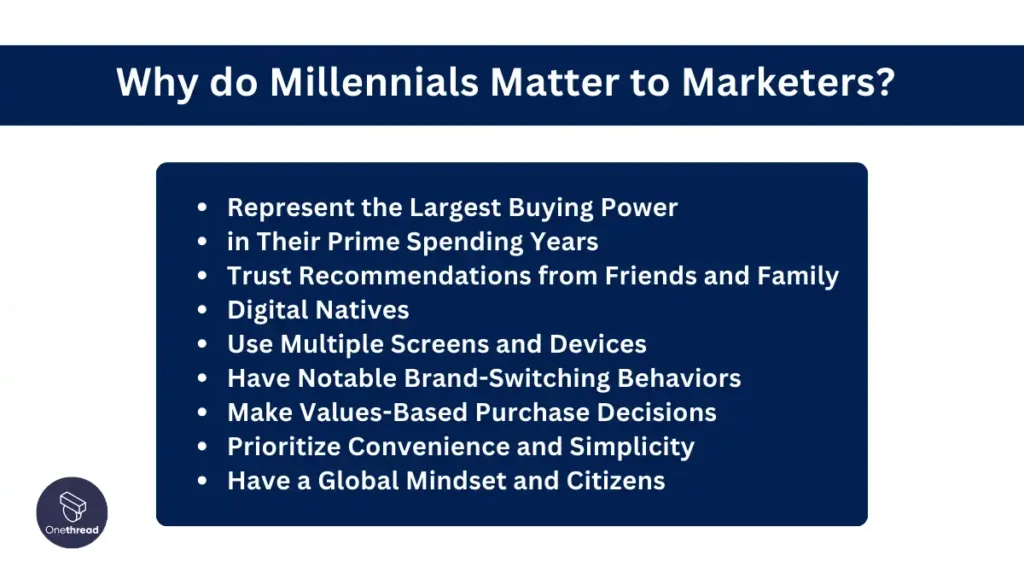

Millennials matter to marketers because of their $2.5 trillion spending power and openness to influence from digital touchpoints. Though budget-conscious, they actually outspend older generations in areas like food, housing, and apparel. This makes them a marketing segment that can’t be ignored.
Millennials rely heavily on mobiles, reviews, and influencers when buying. Meeting them digitally is pivotal – over 50% say they will spend even more online for health products, luxury goods, and apparel in 2023. Convenience through methods like BNPL also appeals to their dynamic incomes.
Ultimately, brands gaining this group’s loyalty will be those speaking authentically about social causes and sustainability. 83% consider a company’s values before purchasing. Personalization also helps retain millennials as they age. Customized digital experiences that adapt to their evolving needs build lasting relationships with America’s largest generation.
Millennials Represent the Largest Buying Power
As the biggest generation, they possess a staggering annual buying power of over 2.5 trillion dollars. Ignoring this influential consumer group means missing out on a significant portion of potential customers.
With peak earning power in their 30s, millennials are making major purchases across categories like homes, cars, and household goods.
Millennials came of age during recessions, leading to delayed and conservative spending initially. Now their sheer numbers drive up prices as they tap into savings, stocks, and wages to acquire adult goods.
Millennials are in Their Prime Spending Years
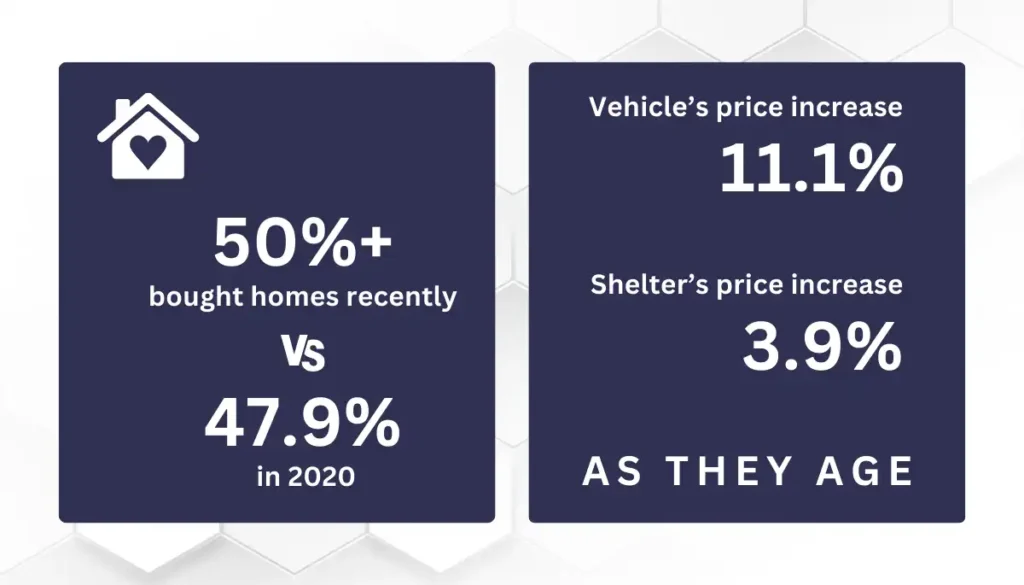

Despite starting careers in debt, millennials are hitting peak earning power in their 30s, fueling major purchases. Now over 72M strong, over 50% bought homes recently versus 47.9% in 2020. With a $2.5T spending capacity, millennials drive growth in cars, household goods, and home prices abroad too.
Though budget-focused earlier in life, millennials are settling down by using pandemic savings, stocks, and wages to acquire adult goods. Their sheer numbers pressure inflation in categories like vehicles (11.1% price increase) and shelter (3.9%), accelerating as they age.
Credit drives purchases too – for instance, millennials comprised over 50% of loan applications to buy homes.
Millennials Trust Recommendations from Friends and Family
89% of millennials believe people in their circles versus brand messages when making purchases. Reviews, referrals, and community trust sustain millennials as loyal buyers.
Many millennials came of financial age surrounded by traditional ads yet lacking funds to buy. Today peer affirmation holds more weight to validate purchases.
Marketers therefore benefit by nurturing organic hype from millennial networks. Enabling advocates to share authentic enthusiasm is more effective than branded promotions alone.
Millennials are Digital Natives
Almost 100% of Millennials use the internet daily. They rely on social media opinions over branding when buying — 89% believe in friends over marketers. Their tech fluency necessitates digital ads to supplement word-of-mouth.
Wary of traditional advertising, millennials seek validation through research, in-store trials, and user reviews before big buys. Yet digital channels earn loyalty by efficiently customizing access to niche products.
Once loyal, millennial shopper relationships stretch advertising dollars over higher-income years. Capturing their preference for tailored digital experiences now pays off long-term.
Three effective approaches include:
- Embracing social media to build brand awareness and loyalty
- Utilizing targeted advertising based on millennial interests and behaviors
- Delivering seamless mobile experiences that align with their expectations.
Millennials Use Multiple Screens and Devices
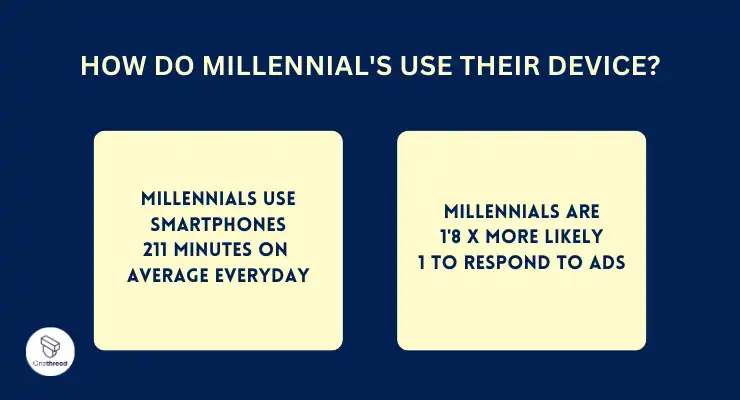



With smart devices being an integral part of Millennials’ lives, brands must comprehend their usage patterns and preferences to engage with this demographic effectively.
Millennials are more accustomed to using mobile devices than previous generations. While many have desktops, they typically use their smartphones for around 211 minutes each day, compared to just 31 minutes on a desktop.
Besides that, they’re more likely to watch video ads on their phones than on TV. Moreover, those viewing these ads on smartphones are often more engaged, being 1.8 times more inclined to respond to the ad. This could be because they’re actively looking up a product while shopping, for instance.
So, when considering how to reach them, it’s clear that mobile is the way to go.
Millennials Have Notable Brand-Switching Behaviors
Despite their familiarity with technology, Millennials are known for their propensity to switch brands as they age. This necessitates a different marketing approach compared to previous generations.
To retain millennial customers, brands must prioritize exceptional customer experiences and leverage data insights to personalize marketing strategies.
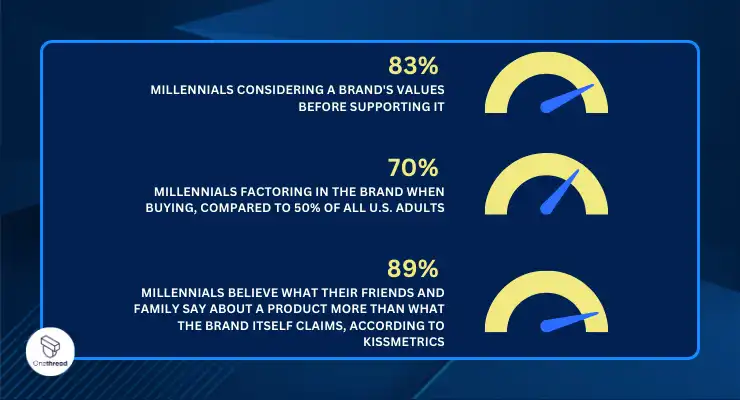



Millennials value brands that match their beliefs, with 83% considering a brand’s values before supporting it. Their spending habits have been influenced by events like the 2008 financial crisis, making them more selective.
They’re more brand-aware than Generation Z, with 70% factoring in the brand when buying, compared to 50% of all U.S. adults.
Millennials Make Values-Based Purchase Decisions
Around 83% of millennials consider a company’s ethics and purpose before buying. They expect authenticity, sustainability commitments, and diversity-focused values. Brands lacking credible stances lose out: millennials will pay more for products aligning with their principles.
Having access to global discourse, this civically engaged generation places scrutiny on business practices at scale. Millennials catalyzed movements like conscious consumerism and ethical sourcing – their convictions now permeate mainstream choice parameters. Leadership that embraces corporate responsibility gains loyalty with globally-minded millennials.
Millennials Prioritize Convenience and Simplicity
The on-the-go millennial lifestyle demands easy, integrated experiences. Options like one-click checkout and buy now, pay later (BNPL) models enable purchases despite budget constraints across dynamic incomes. Fast shipping and omnichannel access also aid adoption.
Raised on instant downloads and same-day delivery, millennials are accustomed to seamlessness. Brands retaining their affinity excelled at mobile-first, unified platforms before they were expected. Friction risks abandonment with this generation; convenience, UI clarity, and payment flexibility earn loyalty by respecting millennials’ time.
Millennials Have a Global Mindset and Citizens
Internet ubiquity gave millennials inclusive worldviews not bounded by geography. Over 70% actively consider global societal impact when buying. These “world citizens” wield borderless influence daily – their digital fluency spreads progressive opinions and brand support globally.
Growing up amid widespread international connectivity shaped millennials’ open-minded, collaborative perspectives. In marketing, their cosmopolitan mindset compels messaging that acknowledges human diversity and welfare worldwide. Companies can leverage millennials’ global citizenship by activating their ethical beliefs and borderless clout to propagate brand messaging at scale.
The Millennial Marketing Landscape
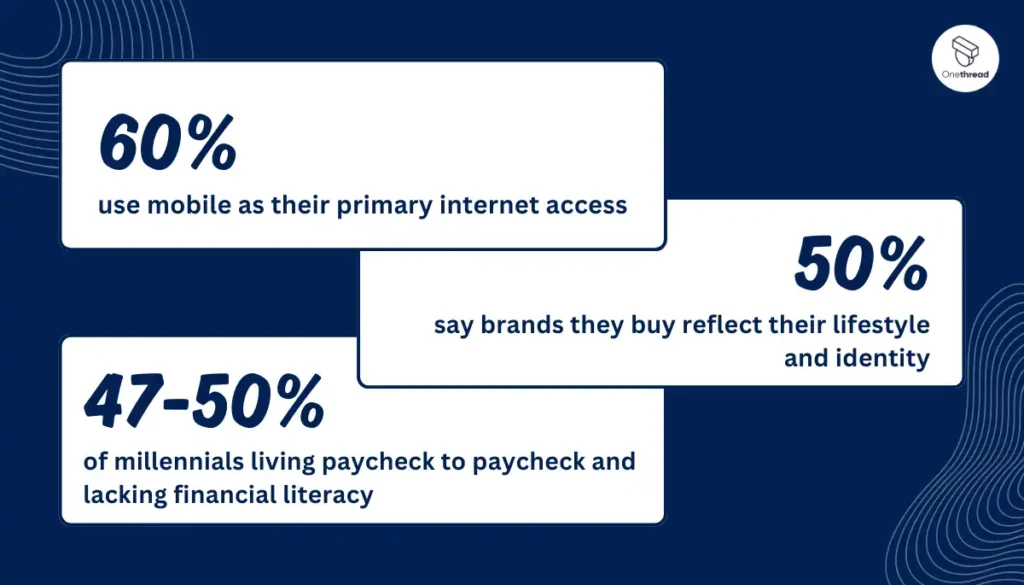

Reaching millennials requires understanding their heavy mobile and social media use alongside values like sustainability. Their 8-second attention spans demand instantly engaging, concise content instead of traditional ads.
Optimizing across preferred platforms like streaming or music apps is essential, as is aligning with identities via subtle, relevant messaging. Financial constraints necessitate affordable pricing and guidance to build loyal relationships.
Specifically, 60% rely on mobile as their primary device, shunning TV/radio/print ads for social and streaming. Targeted digital ads should highlight eco-friendly and socially conscious brand values that 50% say reflect their lifestyle.
With just 28-43 year olds but strong purchasing power, brands must evolve amidst their shifting preferences with personalized recommendations meeting needs around budget-friendly pricing.
Challenges of Marketing to Millennials
Marketing to millennials is difficult because they have short attention spans (8 seconds according to a Microsoft study), skepticism towards traditional advertising, and constantly evolving preferences. Brands must adapt to omnichannel marketing across devices and platforms millennials use while tailoring ads to their identities and values.
Effectively targeting millennials requires understanding their behaviors. 60% use mobile as their primary internet access, demanding fast load times. They increasingly stream entertainment to avoid ads, with Netflix usage surging. Content must be concise and engaging, conveyed across social media and platforms aligned with their values, like how Urban Outfitters’ #UOOnYou campaign resonates by enabling self-expression.
Geo-fencing, beacons, augmented reality, and product customization can capture their attention. Subtle, relevant ads based on their preferences are better than typical “buy now” pitches. 60% say brands they buy reflect their lifestyle, demanding authenticity. 47-50% live paycheck to paycheck, making affordability essential. Financial literacy is low, presenting opportunities to attract them by filling knowledge gaps.
Overall, marketing to millennials requires brands to evolve beyond traditional channels to provide personalized, authentic experiences that engage them where they already spend time. Demonstrating genuine commitment to their values is key. Financial constraints further demand affordable options and financial guidance to earn their loyalty.
To effectively reach them, here are some challenges you can note and overcome.
Getting Their Attention
Millennials have just 8-second attention spans on average based on Microsoft research, requiring marketing content that instantly grabs attention.
With the sheer volume of advertising today, standing out is a challenge, especially when targeting Millennials. Brands need to be creative and unique.
Technologies like Augmented Reality (AR), targeted ads, product customization, beacon technology, and geo-fencing can help engage them. It’s all about offering something different and aligning with their values and preferences.
As the millennial generation’s purchasing power grows, so does the importance of understanding their preferences and behaviors. Brands that can adapt and evolve with this changing landscape will likely find success in the future.
In leveraging the intersection of technology and millennial preferences, innovative strategies like facilitating a survey using a QR code can significantly impact marketing campaigns. By understanding and integrating such tools, marketers are poised to engage with tech-savvy millennials effectively, driving better response rates and enhancing the consumer feedback process.
Finding The Right Medium
60% of millennials use mobile devices as their primary internet access, making optimized cross-device experiences critical. They increasingly stream media rather than watch cable TV ads.
Traditional marketing channels like TV, radio, and print aren’t as effective with Millennials. They’re more inclined to use their devices for almost everything, from social interactions to shopping.
Instead of cable TV, they lean towards streaming platforms like Netflix and Hulu. FM radio? They’ve got music apps. Print media? Think digital books and magazines.
To truly connect with them, brands need to be present where they are, both online and offline. An omnichannel approach, which offers a unified experience across different platforms, can be particularly effective.
Emphasizing Authenticity and Shared Values
50% say brands they buy reflect their lifestyle and identity. Marketing must align with their values around sustainability and social causes rather than hard sells. Phrases like “buy now” or tactics that create a false urgency don’t resonate with them. They prefer making informed decisions based on facts and peer reviews.
So, instead of traditional sales pitches, a more tailored approach using digital advertising, especially when combined with business intelligence and an outreach sales tool, can be more effective.
The idea is to offer suggestions based on their behavior rather than direct ads.
Utilizing Innovative Attention-Grabbing Approaches
Technologies like augmented reality, targeted ads, beacons, and geofencing can break through the information overload millennials experience daily.
- Augmented reality lets them engage with branded content by digitally animating physical spaces, capturing interest across social media.
- Targeted ads personalized to their interests and demographics ensure relevancy.
- Location-based tactics like beacons and geofencing connect with millennials on their smartphones while out shopping.
These innovations provide value rather than noise.
Offering Financial Guidance and Affordability
With 47-50% of millennials living paycheck to paycheck and lacking financial literacy, marketing should focus on providing money management resources.
Many deal with student loans and credit card debt that limit their spending power additionally. Brands that position themselves as financial partners through educational tools and affordable pricing models can earn loyalty.
Developing personalized recommendations tailored to millennials’ financial situations differentiates them from the competition. Addressing monetary knowledge gaps transparently engenders trust.
What Marketing is The Best for Millennials?
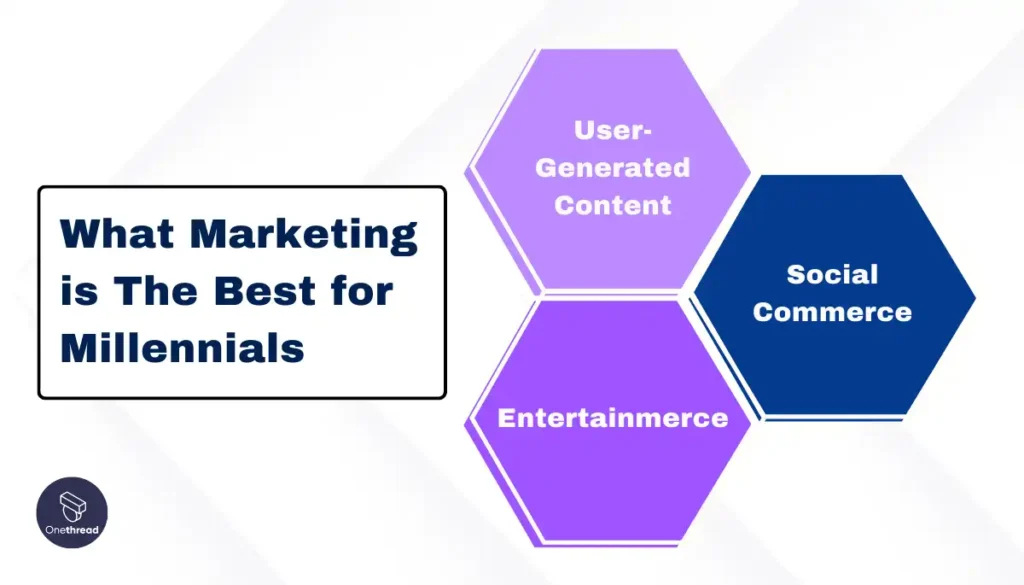

Inbound marketing utilizing authentic content, social commerce, “entertainmerce,” and user-generated content performs best with millennials based on their preferences. These interactive approaches build trusted relationships compared to traditional ads, which only 1% say increases their trust.
Specifically, 84% rely on peer reviews over company-sponsored ads when making purchases. Tapping into user-generated content and curating customer testimonials across social media fosters engagement. Brands leveraging Instagram Reels capitalize on entertainmerce by blending entertainment and shopping in a fun, personalized way.
Overall, marketing succeeds when it Spotlights authentic peer perspectives rather than promotional messaging. Content presented across social platforms as Recommendations aligned with millennials’ interests keeps them actively engaged. Collaborating with influencers, such as an influencer de Monterrey, on creative campaigns generates visibility. Consistently prioritizing value-driven, interactive experiences outperforms traditional advertisements.
To further enhance your marketing efforts, consider using canva or canva alternatives. This will help you create visually stunning and engaging marketing material effortlessly, ensuring your content stands out and resonates with the millennial audience.
User-Generated Content
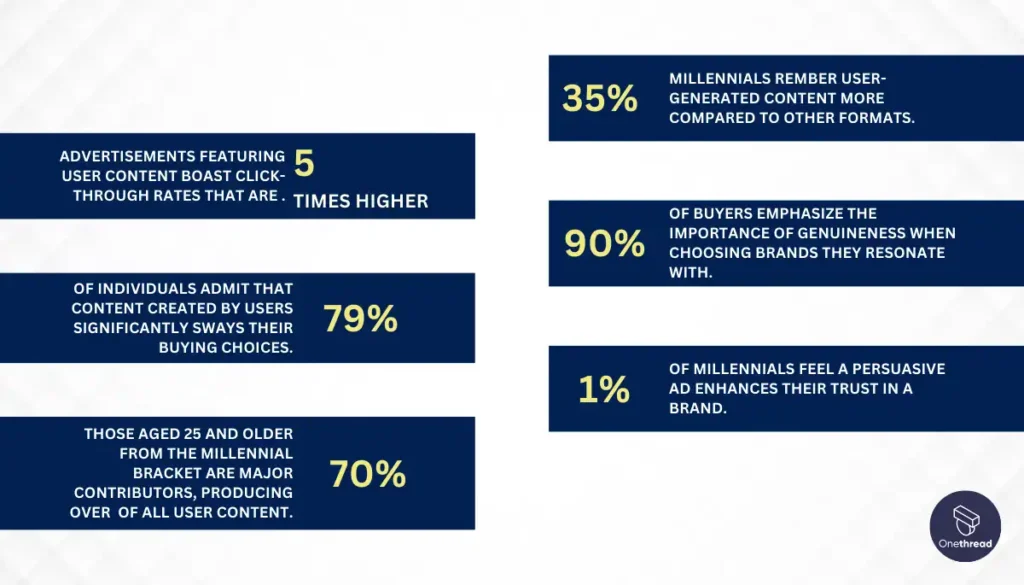

Creating genuine, insightful, and relevant content requires dedication to studying and grasping the preferences of your primary audience, notably the Millennial group. As per Bazaarvoice, 84% of Millennials say that customer reviews and content on company sites play a role in their buying decisions.
Consider these insights:
- Authenticity Matters: 90% of buyers emphasize the importance of genuineness when choosing brands they resonate with.
- Influence of User Content: 79% of individuals admit that content created by users significantly sways their buying choices.
- Ads Aren’t Always the Answer: Just 1% of Millennials feel a persuasive ad enhances their trust in a brand.
- Content Champions: Those aged 25 and older from the Millennial bracket are major contributors, producing over 70% of all user content.
- UGC and Engagement: Advertisements featuring user content boast click-through rates that are 5 times higher.
- Memorability of UGC: For Millennials, user-generated content is 35% more lasting in memory compared to other formats.
The core insight? Millennials excel both as creators and consumers of content.
Regarding that, it’s clear that Millennials are well-versed in these tactics. It’s crucial for brands to devise methods to curate content specifically tailored for them, rather than merely showcasing new offerings.
It’s essential to build relationships through user-contributed content that promotes active participation and involvement.
Content that prioritizes the customer is the golden ticket to building trust and genuine connections with Millennials. It’s worth noting their inclination to broadcast their entire buying process – from contemplation and acquisition to utilization.
So, leveraging user-contributed content doesn’t just increase brand visibility; it can also introduce your brand to new audiences, potentially converting them into devoted patrons.
Social Commerce
Most Millennials spend over 2 hours daily on Facebook, making it a prime spot for marketing to them. Social shopping is changing how they buy online, especially on platforms like Instagram, Pinterest, and Facebook. In fact, HubSpot states that 90% of them are on Facebook.
With a large number of Millennials active on social media, marketers can offer personalized recommendations based on browsing behavior and interests.
Entertainmerce
Entertainmerce, the fusion of entertainment and e-commerce, offers an enjoyable and engaging shopping experience for Millennials.
Brands can use social media platforms like Instagram Reels to showcase entertaining content while featuring product tags. But they have to be alluring and authentic to gain trust. Because, according to Hubspot, 84% of Millennials aren’t convinced by regular ads.
Hosting virtual events and partnering with influencers who create engaging content can also captivate Millennials and promote products in a fun and authentic way.
Incorporating strategies like engaging Millennials with promotional products further enhances the bond and appeal to this group.
By embracing entertainment, marketers can successfully capture the attention and interest of this demographic without resorting to pushy marketing tactics.
Best Practices of Millenial Marketing
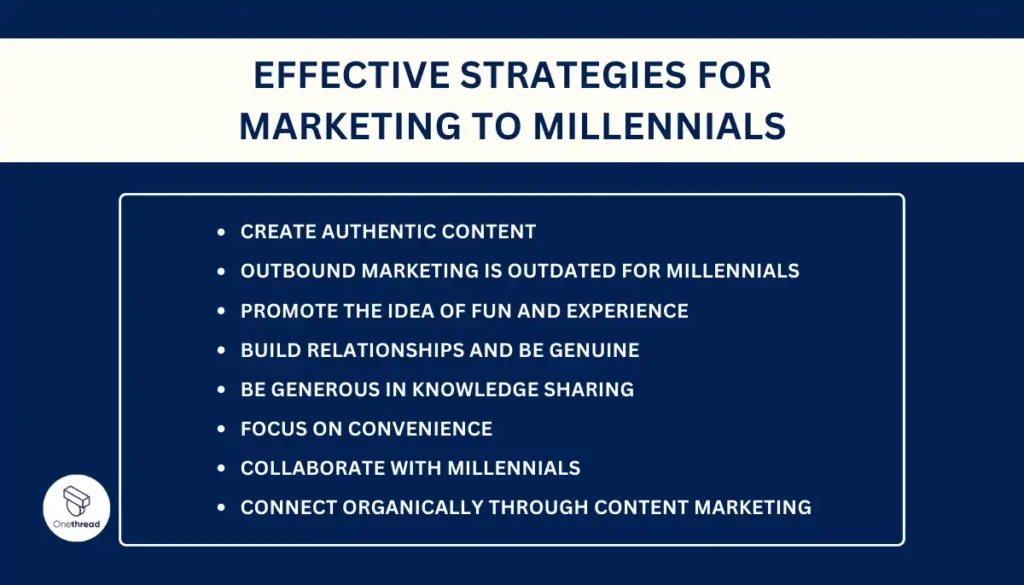

Some best practices of millennial marketing are focusing on value and experience over products, transparency through authentic stories, personalization tailored to their interests, and social engagement via platforms they actively use.
65% are saving for travel rather than material goods, valuing shareable experiences that convenience their lifestyle.
Brands like Coca-Cola collaborate directly with millennials on product development through surveys and focus groups, respecting their opinions to nurture loyalty. Content presented as stories across preferred social platforms should highlight practicality and be informative or entertaining based on actual usage data and feedback. This authentic co-creation process fosters genuine connections.
Here are some key Millennial marketing strategies to connect with this generation effectively and make a lasting impact.
Create Authentic Content
To succeed, it’s a must to create authentic content for Millennials that resonates with their values and beliefs. Understanding what type of content Millennials like is essential for this attempt. Unlike previous generations, they value authenticity, transparency, and social responsibility.
Being genuine appeals to everyone, but Millennials value it even more than older generations like Boomers and Gen X. They prefer making choices on their own terms.
And they might even watch a Facebook ad and click on it if it resonates with their beliefs. However, if brands try to fit in without being true to themselves, they often spot the mismatch.
If you’re using AI-generated content as part of your strategy, it’s crucial to make sure it doesn’t feel robotic or generic. This is where an AI Humanizer comes in—iit helps humanize AI text so that it feels natural, human, and emotionally engaging, making it more likely to connect with Millennial audiences.
Additionally, only about 30% of them tend to stick with the same brand, showing less brand loyalty than earlier generations.
Hence, brands should focus on building genuine relationships to establish trust and loyalty by providing valuable information and entertainment that aligns with their interests.
It’s possible through partnerships with influencers or by showcasing real people’s experiences with the brand, creating a community where Millennials feel seen, heard, and valued.
Outbound Marketing Is Outdated For Millennials
Outdated outbound marketing methods, such as magazine ads and direct mail campaigns, don’t resonate with Millennials. Instead, brands should adopt inbound marketing strategies that bring “interests and values”.
By understanding applied psychology principles, brands can better tailor their marketing strategies. This allows them to effectively advertise to a millennial audience, capturing their attention and driving conversions.
For example, appealing to their values through eco-friendly packaging or emphasizing safety features for baby boomers. By providing value and establishing trust, brands can form genuine relationships with Millennials and build a loyal following.
Promote The Idea Of Fun And Experience
To engage today’s tech-savvy Millennials, brands should choose fun and experiential approaches in their marketing promotions.
By applying psychology to the marketing strategy, brands can create interactive experiences that make them feel involved with the product or service.
Millennials often find the journey of shopping more exciting than the actual buying. They enjoy the process of exploring and researching products online, sometimes even more than owning the item.
This trend, known as “Fauxsumerism,” is evident in platforms like Pinterest, where users create wish lists and curate collections of items they’re interested in.
For businesses, it’s essential to offer an engaging online browsing experience, making it both fun and interactive. Using tools like an online flyer maker to create eye-catching, shoppable flyers is one effective way to achieve this. These flyers can spark curiosity and encourage interaction, turning passive viewers into active participants.
This approach not only captures their attention but also encourages them to engage with the brand.
These methods go beyond traditional outbound marketing and foster genuine relationships with potential customers, extending beyond a one-time purchase.
Build Relationships And Be Genuine
Building genuine relationships is crucial when targeting Millennials, who value authenticity and transparency.
Brands can connect with them by sharing stories and interacting on social media, showing they see them as people, not just buyers.
By getting the mindset of Gen Y and using some basic psychology, marketers can build genuine bonds and earn their trust and loyalty.
Be Generous In Knowledge Sharing
Sharing valuable information through inbound marketing for Millennials is a solid method to connect with them. As brands explore how to sell to Millennials, leveraging informative content becomes the key.
By sharing informative content like e-books, videos, and blog posts, brands can position themselves as authorities in their specific domains.
Applying psychology principles, such as using emotional triggers and visual content, can increase engagement. With these techniques, brands can attract and engage Millennials, providing them with valuable information that improves their lives and strengthens their authentic connection.
Focus On Convenience
To appeal to Millennials, brands should emphasize the convenience and practicality of their products or services. They value experiences over material possessions and appreciate products that make their lives easier and simpler.
Ever heard the phrase “Pics or it didn’t happen” online? It’s a common saying among Millennials, highlighting their focus on experiences.
The 2008 financial crisis shaped their views on spending, leading many to value experiences over material possessions. In fact, around 65% of Millennials are saving for travel. To market effectively to them, it’s essential to grasp this preference.
However, it’s not just about being careful with money. Some argue that Millennials prioritize content they can share with others. As Blake Morgan mentions in Forbes, today’s consumers often value a memorable moment they can post on Instagram over the latest trendy purchase.
So, by highlighting how a product or service solves everyday problems and is easily accessible and user-friendly, brands can capture the attention of this generation.
Collaborate With Millennials
Collaboration is key when targeting Millennials, as they value transparency and authenticity. Brands should create opportunities for collaboration, such as hosting focus groups or surveys, to gather insights and involve Millennials in the development process.
Millennials today want a role in shaping the products they use. About 42% express interest in aiding companies in designing upcoming products and services. Traditionally, companies make products and hope their target audience likes them. But they want a hand in the creation process.
Companies that involve them in product development tend to do better. The key for marketers is to nurture a bond with consumers, supporting their individuality and personal brand building.
Take Coca-Cola as an example. They invited their audience to share their take on the brand’s message of “Energizing refreshment.” People were free to represent this idea in any creative form, from videos to illustrations.
Coca-Cola then incorporated these contributions into their global marketing campaigns. This approach allowed Millennials to infuse a bit of their essence into a product tailored for them, while Coca-Cola gained a genuine touch in their promotions.
Overall, by respecting their opinions and needs, brands can create loyal customers and produce offerings that resonate with this demographic. This organic approach encourages connections and turns Millennials into brand ambassadors.
Connect Organically Through Content Marketing
Connecting with Millennials organically requires creating content that speaks to their interests and values. As tech-savvy individuals, Millennials spend significant time on social media platforms.
Therefore, brands must establish a genuine presence on these platforms by actively engaging with their audience through comments, likes, shares, and direct messages.
To connect organically with Millennials, brands should focus on creating informative and entertaining content. By creating stories that resonate emotionally or intellectually with Millennials, brands can tap into their motivations and aspirations.
:In addition, focus on creating content that is comprehensive yet concise at the same time. Provide maximum amount of information while using as much less words as possible. Use a summarizer to get rid of jargon, complex words, or unnecessary information.
This approach goes beyond merely selling a product or service; it allows brands to become a part of Millennials’ lifestyles.
By targeting marketing for millennials through content marketing, brands can provide value, establish a sense of authenticity, and cultivate a strong connection with this demographic.
Targeting Millennials through Content Marketing: Key Strategies for Success
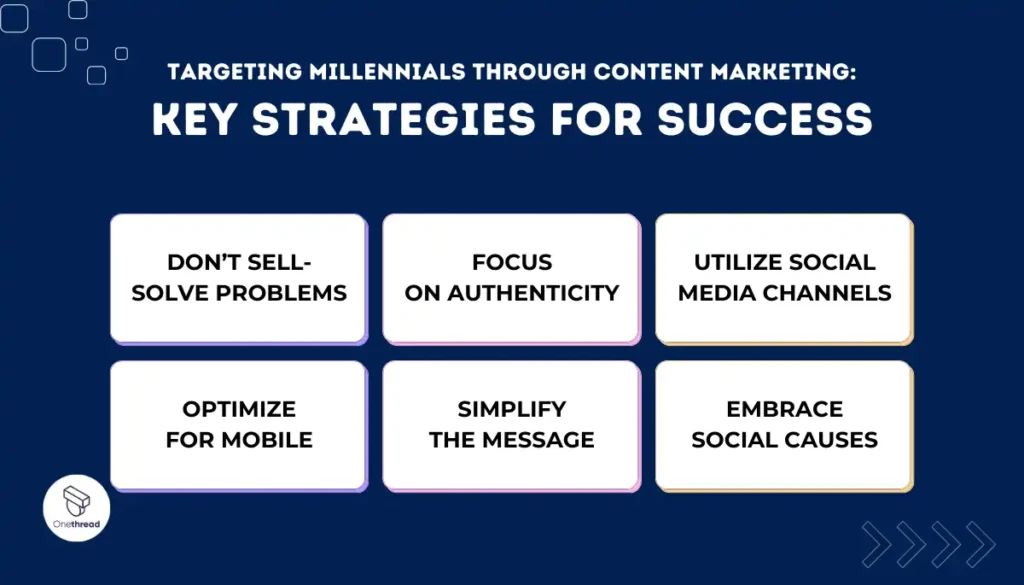

To connect with Millennials, content marketing is a must. By tailoring content to their interests and values, brands can effectively engage this influential generation. Let’s explore the strategies that work best.
Don’t Sell – Solve Problems
To effectively target Millennials through content marketing, you must adopt an authentic approach that focuses on engagement rather than direct sales. This generation values transparency and seeks informative and entertaining content.
By providing valuable and interesting content, you can build trust and position your brand as a thought leader in your industry.
Focus on Authenticity
To connect with Millennials in an authentic way, incorporate real customer stories, user-generated content like social posts, and behind-the-scenes glimpses into your brand. These provide genuine perspectives into the customer experience, fostering trust. Let Millennials see real people enjoying your products and honest reviews. Give sneak peeks into product development, company culture, and brand initiatives to appear transparent.
Utilize Social Media Channels
To reach Millennials effectively, it’s important to establish a strong presence on marketing channels for Millennials, like social media platforms, since almost half of Millennials turn to social media to discover new trends.
They’re highly engaged on platforms like Instagram and Snapchat, making them ideal channels for connecting with this demographic.
However, simply being present is not enough. Brands should create valuable content, such as high-quality photos and videos, and engage with followers through comments and direct messages, fostering trust and loyalty.
Optimize for Mobile
With Millennials constantly accessing content on mobile, it’s vital to optimize for these devices. Use bite-sized chunks of content that can be quickly scanned on a small screen. Ensure text and visuals are legible across different displays.
Key details should pop out and every component needs to work seamlessly on smartphones. Keep load times fast. Allow easy sharing. Craft content for multi-device use to effectively permeate Millennials’ digital ecosystem.
Simplify the Message
To capture the attention of Millennials, it’s important to simplify your messaging and use concise language. Millennials are constantly bombarded with information, so using bullet points, avoiding lengthy text blocks, and getting straight to the point can help your message resonate.
By simplifying your message, you can enable Millennials to retain important details and act based on their learning.
Embrace Social Causes
Millennials are deeply connected to societal and political issues. Brands that openly address and align with these concerns often resonate with them.
To effectively engage with this demographic, brands should cover recent societal developments, be transparent about their workplace and eco-friendly initiatives, and showcase their contributions to society.
By highlighting your company’s initiatives and positive contributions towards society, you appeal to their values and emphasize the importance of supporting socially responsible businesses.
Now, let’s explore how brands can utilize paid advertising to target Millennials.
Targeting Millennials through Paid Ads: Effective Strategies for Success
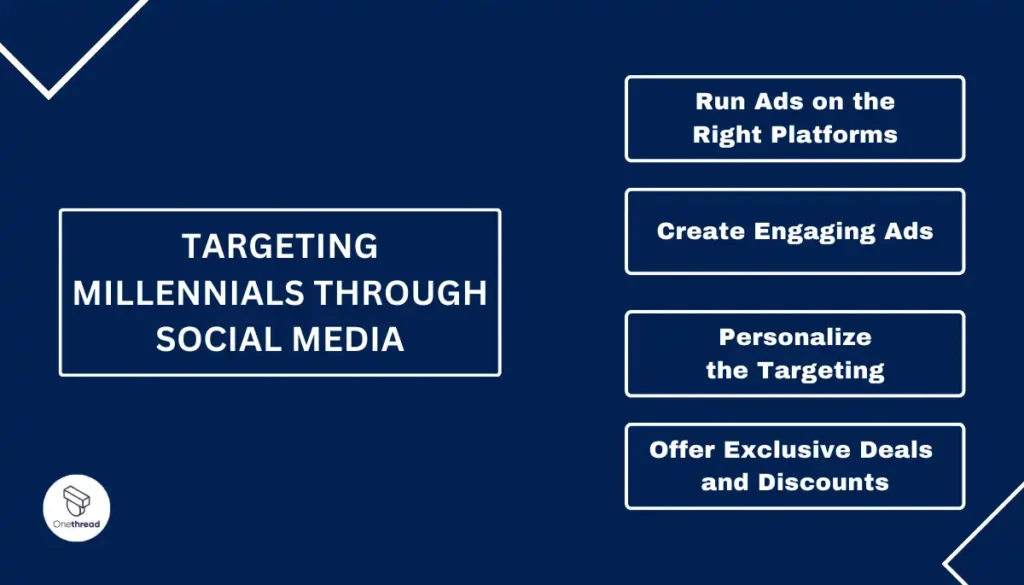

Capturing the attention and engagement of Millennials is crucial for any modern business. Here are some of the best ways to advertise to Millennials to help you effectively target this influential demographic through paid advertising.
Run Ads on the Right Platforms
For optimal marketing to Generation Y, it’s essential to do paid ads on the social media platforms they use most often, such as Facebook, Instagram, Twitter, YouTube, Snapchat, and Pinterest. Understanding how to advertise to Millennials requires recognizing their preference for multimedia content.
The video ads get more traction than ones that aren’t because 70% of Millennials are more likely to trust brands that have product videos compared to those that don’t.
Design your content for each platform’s unique features and target audience to deliver personalized messages that reflect this generation.
Create Engaging Ads
Humor plays a significant role in Millennials’ culture, making funny ads an effective strategy to engage them. Incorporate memes and humorous elements into your advertisements to catch their attention and differentiate your brand.
Funny ads have a higher likelihood of being shared, increasing exposure and user engagement. Ensure the humor aligns with your brand values and resonates with your target audience.
Personalize the Targeting
Appealing to Millennials’ emotions can foster a sense of connection and loyalty towards your brand.
Create content that evokes nostalgia, uses storytelling to convey brand values, and showcases how your product or service has made a positive impact.
According to Deloitte, 72% of Millennials prefer ads tailored to them over general ones. So, encourage user-generated content to involve your followers and feature their experiences.
Aligning your brand with social causes that they care about can also inspire positive emotions and deepen the connection.
Offer Exclusive Deals and Discounts
Millennials love discounts and special offers tailored just for them. Provide exclusive discounts and flash sales only for new email subscribers or social media followers. Create unique coupon codes to make them feel valued. Release limited-edition products with must-have appeal. Host contests and giveaways of highly desirable prizes to generate buzz.
Leverage FOMO by emphasizing the exclusivity of these deals. Limited time frames also motivate quick action. Promote influencer collaborations on specialty lines.
The thrill of gaining VIP access drives engagement among Millennials. Incentivize sharing user-generated content for additional reach. Exciting deals keep your brand top-of-mind.
Targeting Millennials through Social Media: Effective Strategies for Success


To capture the attention of Millennials when you manage social media accounts, you need to tap into social media. This tech-savvy generation spends significant time scrolling through platforms like Facebook, Instagram, TikTok, and Twitter.
So, understanding how to target Millennials on social media is crucial for any brand aiming to engage with this demographic. However, before diving into the strategies, let’s check out the social media platforms in brief.
Be Proactive and Engaging
In addition to focusing on values, it’s important to be proactive and engaging when targeting Millennials on social media. Actively seek interactions with your audience and provide exceptional customer service.
Most Millennials, around 80%, like it when brands are fun and entertaining. They also like to share their thoughts and feedback, with about 7 out of 10 feeling it’s their job to do so. Additionally, around 4 out of 10 want to be involved in making brands and products.
Take the initiative in resolving issues and offering solutions to build stronger relationships with millennial consumers.
Build Authentic Relationships
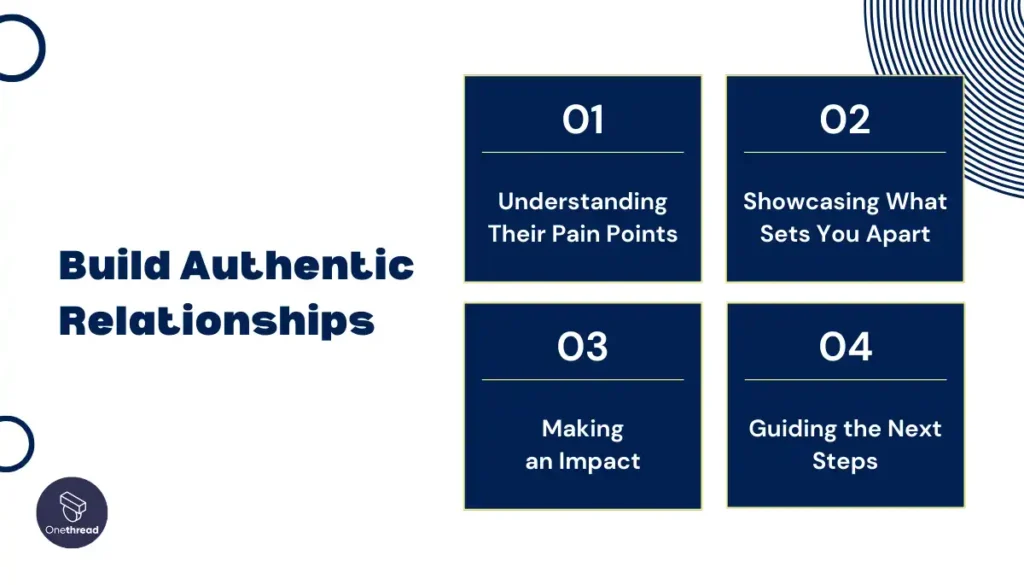

In sales, it’s all about the experience. Pushy tactics? NO, That’s old school.
Today, it’s all about genuine, helpful content. Especially when you’re talking to Millennials. They don’t just want a sales pitch—they want a sales pitch deck with real answers and solutions.
Here’s a guide to help you build content that really speaks to them.
Step 1: Understanding Their Pain Points
What challenges are Millennials facing? Identify issues your product can solve by responding to comments and questions on social media and blogs. This shows you’re listening.
Step 2: Showcasing What Sets You Apart
Here’s your chance to shine! Tell them why you’re different, and give some knowledge about what you offer. Run live Q&A sessions on Instagram and Facebook to demonstrate your product benefits. Give real-time answers to build credibility.
Step 3: Making an Impact
How do you offer to change things for the better? Maybe it’s about enhancing their daily routine, being eco-friendly, or boosting well-being.
Step 4: Guiding the Next Steps
Now, don’t leave them hanging. Guide followers to further content on your site, email newsletter signups, or special offer pages. Infuse prompts with authenticity by incorporating influencer quotes and testimonials.
Focus On Authentic Values
To effectively target and understand how to reach Millennials on social media, This generation seeks brands that align with their values of sustainability, inclusivity, and social responsibility.
According to PRC, 73% of Millennials think the internet is good. That’s why, you should communicate your brand’s values effectively and take action toward causes that resonate with them.
You can build authentic connections and long-lasting relationships based on shared values by demonstrating genuine concern and actively addressing pressing issues.
Leverage Influencer Marketing
Partnering with social media micro-influencers who authentically align with your brand can be highly effective for reaching Millennials.
Carefully vet potential partners to ensure their content and values match yours. Seek those creating engaging lifestyle content in your niche with strong, targeted followings. Offer to collaborate on sponsored posts, giveaways, and co-created products for their engaged audiences. Compelling influencer endorsements lend credibility and expose your brand to new millennial consumers.
Additionally, tracking the success of these partnerships is essential. Use various influencer analytics platforms to measure KPIs such as engagement rates, follower growth, and conversion metrics. For a free option, try an engagement rate calculator.
These tools provide valuable insights into which influencers drive the most impact, allowing you to refine your strategies and optimize future collaborations for better results
Though smaller in following than celebs, micro-influencers drive engagement and conversions. Keep partnerships going with consistent value exchanges. Cultivate brand advocates by treating influencers as true collaborators.
Social Platforms And Millennials
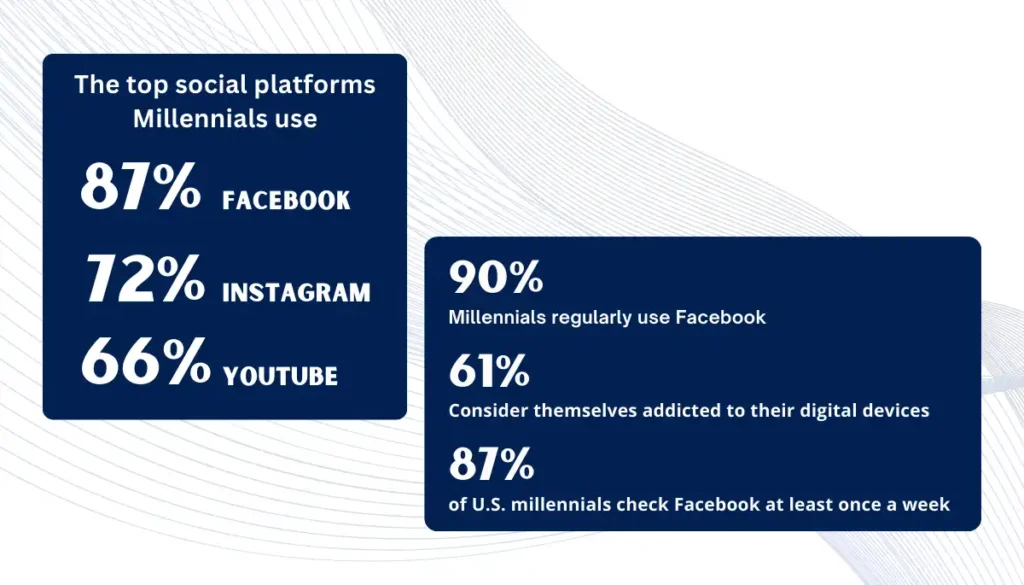

When targeting Millennials, it’s vital to understand their social media habits. The top social platforms Millennials use are Facebook (87%), Instagram (72%), and YouTube (66%).
A striking 87% of U.S. millennials check Facebook at least once a week, making it the most used platform. Overall, 90 percent of millennials regularly use Facebook, whether through mobile devices or otherwise.
And yes, millennials are obsessed with social media – 61% say they consider themselves addicted to their digital devices overall. This reliance on social platforms makes millennials a key target audience for marketers across these networks.
So marketers must leverage these preferred networks, optimize content for mobile, and craft compelling ads that grab attention. Now let’s explore specific strategies for key platforms.
Facebook & Instagram
On Facebook specifically, its advertising tools excel at targeting millennials and enabling genuine engagement. Brands can join existing conversations and come across as open and ready to chat. Similarly, Instagram’s visually-driven feed makes 72% of millennials flock there daily. Promotions with eye-catching images or videos tend to grab their attention.
Want to reach Millennials on Twitter? Meet them where they’re most comfortable. Video-enhanced sponsored tweets can make a big difference.
Plus, the data suggests that the Millennials on Twitter often have a bit more to spend. So, it’s a surprisingly good spot for promoting premium products.
With its median user age around 40, Pinterest is a hotspot for older Millennials. These users often have a stable job, some savings, and are ready to spend. That’s a good combination for any marketer!
YouTube
YouTube is all about striking visuals that click with Millennials. And while there’s a diverse audience here, it’s an excellent place to learn the ropes of marketing to this demographic.
The recipe? Grab their attention in the first moments, offer value, and come across as genuine, open, and ready to chat. Whatever your niche, you want to create video that millennials will enjoy, don’t forget about trending YouTube hashtags as an excellent tool for finding you among the multitude of content.
You can also figure out how to get the transcript of a YouTube video to enhance your reach and tailor it to millennials
Now, let’s check out the strategies you can use on these social media to grab Millennials’ attention.
Effective Millennial Acquisition Strategies for Marketers
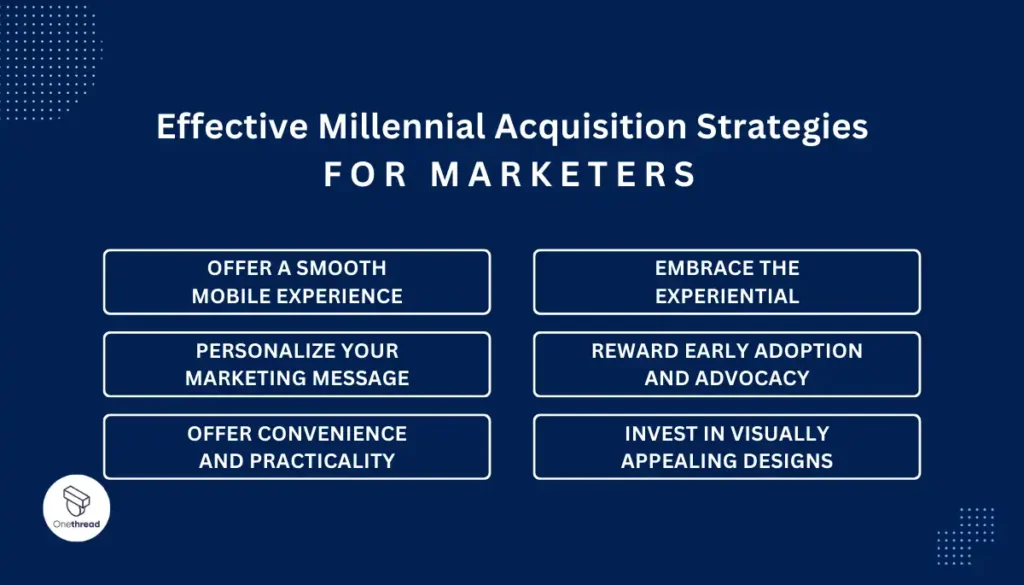

Some of the most effective Millennial acquisition strategies for marketers are: offer a smooth mobile experience with fast load times, clear navigation, and engaging content; personalize marketing messages to connect emotionally; provide convenience through easy payments, and shipping, and subscriptions; embrace experiential marketing with contests and exclusivity; reward early adoption and advocacy; and invest in visually appealing designs featuring vibrant colors and quality graphics.
Let’s explore the key tactics in detail to engage and acquire millennial customers.
Offer A Smooth Mobile Experience
Make your website and content easily accessible on smartphones with fast load times, clear navigation, and calls-to-action. Develop engaging mobile apps. Videos, photos, and easy-to-read content improve mobile user experience.
Having a mobile-friendly site is a must these days. Why? Well, most people use smartphones, Especially Millennials, who seem to be always glued to their screens. Did you know that they use their devices for over 5 hours daily?
So, making sure your content is easily accessible on mobile isn’t just a suggestion—it’s a necessity.
Embracing a mobile-first experience captures their attention and keeps your brand relevant in today’s digital landscape.
So, how to make your content mobile-friendly? Here’s how:
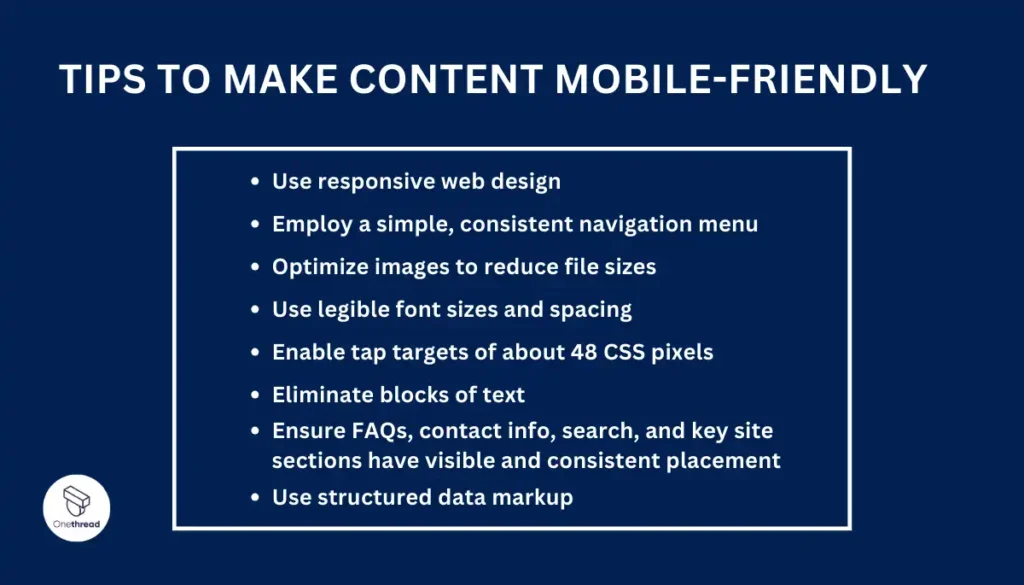

Here are some tips for making content mobile-friendly:
- Use responsive web design that adapts to different device sizes. Media queries allow your website to detect screens sizes and adjust layouts accordingly. This ensures proper formatting and readability on phones or tablets.
- Employ a simple, consistent navigation menu that works across devices. Dropdown menus or “hamburger” menus work well for compacting navigation. Ensure buttons and links have enough space around them for accurate tapping.
- Optimize images to reduce file sizes. Scale pictures appropriate to page width, compress files, and use lighter image formats like WebP. Faster load times improve user experience.
- Use legible font sizes and spacing. Paragraph text should be at least 16px and have line spacing around 1.5em for readability. Apply a maximum width for paragraphs to prevent extended horizontal scrolling.
- Enable tap targets of about 48 CSS pixels, with enough surrounding space. This makes it easier for users to accurately select elements on touchscreens.
- Eliminate blocks of text where possible through concise writing and bullet points. Reading long passages is more difficult on mobile. Prioritize scannability.
- Ensure FAQs, contact info, search, and key site sections have visible and consistent placement across devices. Familiar patterns improve findability.
- Use structured data markup to enable voice search and improve SEO. This allows content to be discoverable by digital assistants.
Following responsive design best practices tailored to smaller screens allows you to effectively optimize content for mobile users.
And there you have it! Simple tips, but they can make a huge difference for your mobile users.
Personalize Your Marketing Message
To create a deeper emotional connection with Millennials, personalization is key. Tailor your message to speak directly to individuals, understanding their unique needs and interests.
Incorporating customer testimonials and real experiences from other consumers can build trust and authenticity. By showcasing personal stories, you can better connect with Millennial buyers and increase the likelihood of conversion.
Offer Convenience and Practicality
Millennials value convenience and practicality when making purchases. Consider offering easy payment options like Apple Pay or PayPal, fast and reliable shipping, and subscription services that deliver products automatically. Providing a smooth, no-hassle customer experience will appeal to millennial buyers.
You could highlight testimonials from happy customers raving about the convenience of your payment and shipping options. Create messaging around how your subscription services eliminate the effort of remembering to reorder frequently purchased items. Convenience draws in millennial shoppers.
Embrace the Experiential
Millennials crave experiences. Develop contests and sweepstakes that offer exclusive access, events, or opportunities to engage with your brand in an experiential way. Gamification, through point systems and rewards, also appeals to the millennial target market.
Leverage user-generated content by sharing photos and videos from past events or contests. Build hype by teasing upcoming experiences that showcase your products or brand in an exciting, share-worthy light. The thrill of exclusivity and participation attracts millennial consumers.
Reward Early Adoption and Advocacy
Offer referral programs and special perks to engage early adopters and turn them into brand advocates. Provide exclusive access or product discounts to loyal, long-time millennial customers as well.
Promote the social clout that comes from being among the first to buy your new product line or an early ambassador for your brand. Millennials are drawn to feeling like insiders, with incentives that reward their loyal support. Celebrating your VIP millennial advocates inspires further word-of-mouth marketing.
Invest in Visually Appealing Designs
Capturing the attention of Millennials requires investing in visually appealing designs. This generation is drawn to eye-catching graphics and images.
According to Venngage, more than half of the people who do marketing believe that using pictures and videos is really important for their marketing plans.
So, to stand out, incorporate vibrant colors, utilize animations to bring visuals to life, and embrace white space to allow focus on essential elements.
By investing in high-quality visuals that align with your brand, you can effectively grab the attention of Millennials and leave a lasting impression.
A Few Last Words: Expert Advice for Winning Over Millennials!
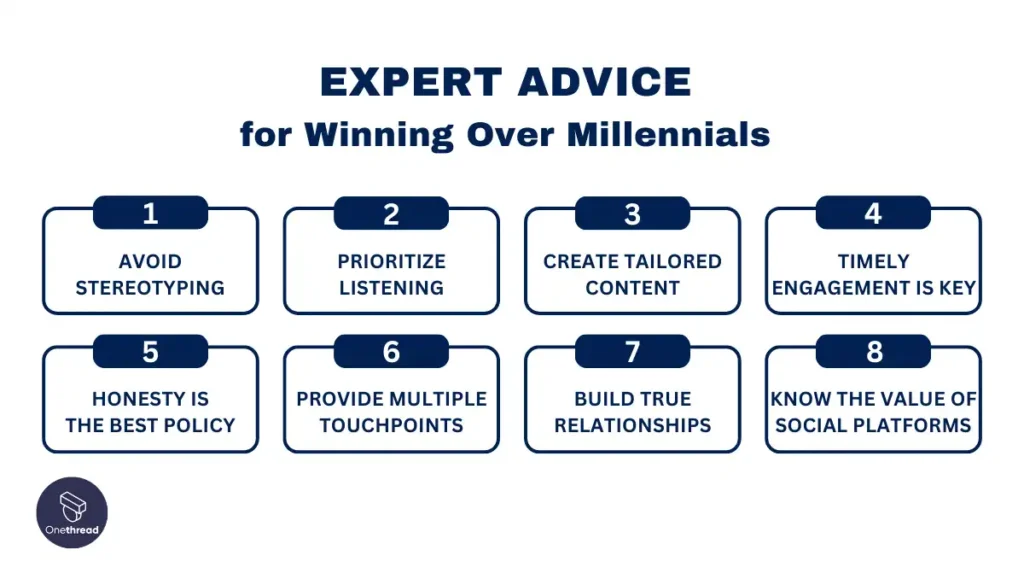

As we wrap up, remember: Millennials seek brands that align with their values and offer genuine value. Prioritize clear communication, authenticity, and social responsibility.
When considering how to market to Millennials, the expert tips shared here can serve as your blueprint to connect with this dynamic demographic.
Avoid Stereotyping
When aiming at Millennials, avoid broad assumptions about their preferences and beliefs. While it’s okay to infer about tech or societal shifts, always treat the millennial buyer as a unique individual, not just a demographic stereotype.
Prioritize Listening
Tools that facilitate understanding are crucial for millennial outreach. Engage in social monitoring, direct conversations, or market studies to grasp what Millennials really want. Identify what sets them apart and the kind of narratives they gravitate towards.
Create Tailored Content
To truly engage, produce content tailored to Millennials. Narratives that are personal and relatable will strike a chord with them.
Timely Engagement is Key
While timeless content has its place, content that’s current and grabs attention is vital for reaching the ever-busy Millennials. Dive into trending topics and produce content that sparks interest and compels them to interact.
Honesty is the Best Policy
Always maintain transparency with Millennials. If a product isn’t right for them, be upfront. Suggest alternatives or give useful advice, even if it leads them elsewhere. They value forthrightness and will likely share their positive experiences, especially on social platforms.
Provide Multiple Touchpoints
For millennial outreach, offer various channels for them to connect with your brand. Be it through social platforms, your website, or chat services, being accessible is key.
Build True Relationships
Even with the omnipresence of digital communication, Millennials often lack deep personal connections. But they value genuine brand relationships.
So, when crafting your outreach strategy, focus on building trust. Engage with them on social platforms, respond to their queries, and interact without always pushing a sale.
Entice with Perks and Rewards
Millennials love to showcase their experiences online. They’re more inclined to interact with brands that offer rewards. Innovative engagement methods can garner their attention.
And if they give feedback, highlight it on your platforms, giving it a personal touch by tagging them.
Know the Value of Social Platforms
Millennials are deeply embedded in the social media landscape. They invest hours daily browsing posts from peers, celebrities, and thought leaders, which influence their purchasing choices. Thus, a strong social media presence is essential.
To maximize your social outreach:
- Use live streaming platforms like Facebook Live to present your brand and engage authentically.
- Organize social contests prompting them to showcase your product in use.
- Collaborate with thought leaders who can offer a fresh perspective on your brand, amplifying your reach.
Planning an Effective Millennial Marketing Campaign with OneThread
Onethread is not just another project management tool; it’s your gateway to turning insights into actionable steps, especially when it comes to advertising to Millennials.
With the rise of the millennial demographic as a potent market force, it’s crucial to have a tool that can help you organize these insights, plan your campaign, and align your team for precise marketing execution.
Why Choose Onethread?
Efficient Planning and Execution:
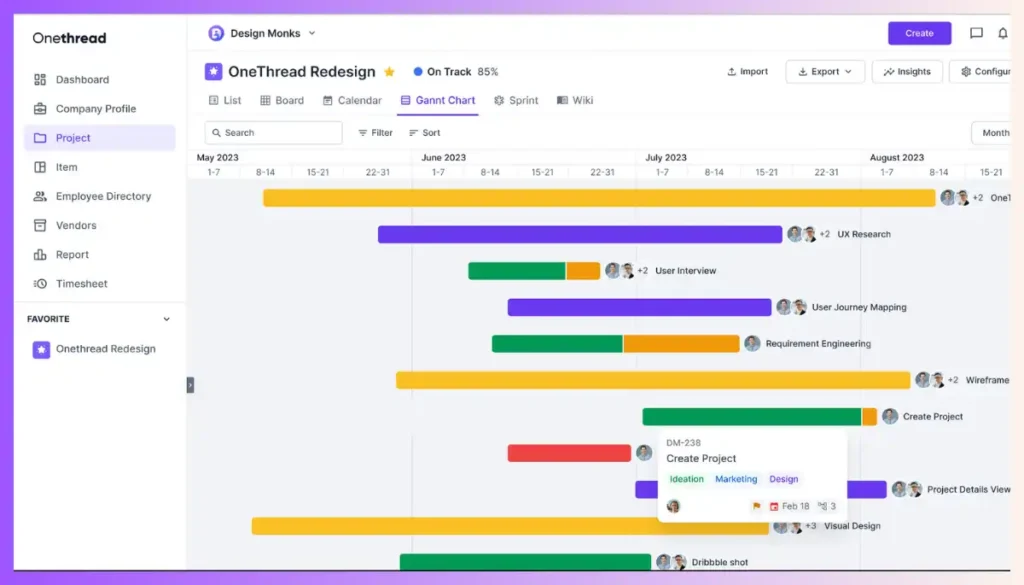

A millennial-targeted advertising campaign doesn’t materialize out of thin air. It requires meticulous planning and execution, and Onethread provides the perfect platform for it.
Templates for Precision:
Onethread offers tailored solutions to help you focus on the millennial demographic, ensuring you target one of the most influential segments effectively.
Break Down Complex Projects:
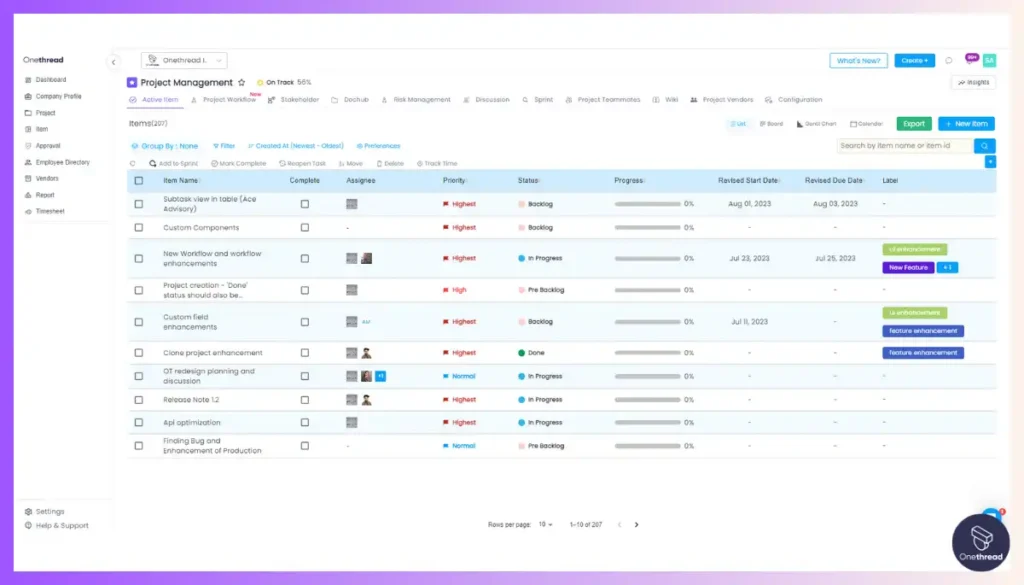

Using Onethread, you can segment your campaign production into manageable steps, ensuring you never feel overwhelmed at any stage.
Unified Team Communication:
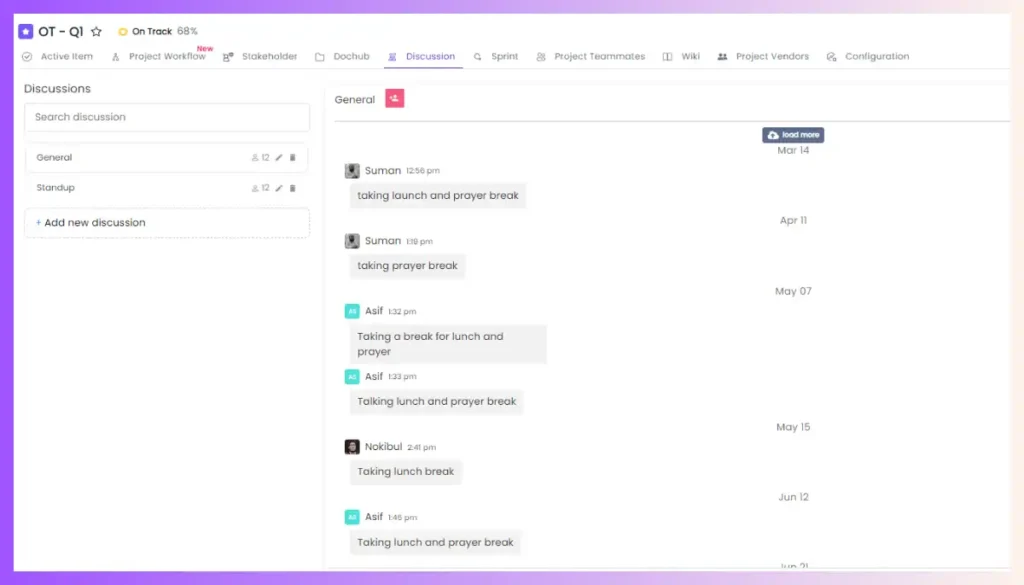

Integrate your entire team into Onethread, ensuring everyone is aligned with the brand messaging and authenticity. Speaking to Millennials requires a unified voice, and Onethread ensures that.
Kickstart Your Campaign:
Onethread allows you to initiate a marketing campaign, design, plan, visualize, and communicate every step of the way.
Segmented Workflow Stages:
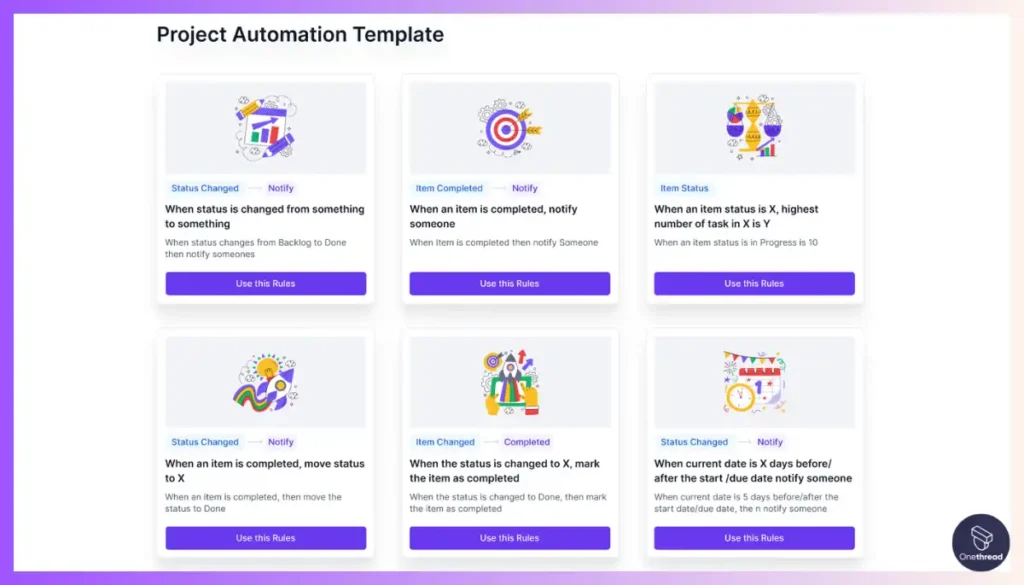

Divide your marketing campaign into different workflow stages, ensuring clarity from inception to execution. Onethread ensures your marketing team remains synchronized and meets set milestones.
Millennial-Focused Templates:
Onethread offers specialized templates tailored for millennial-focused campaigns, ensuring you target this crucial demographic effectively.
Comprehensive View:
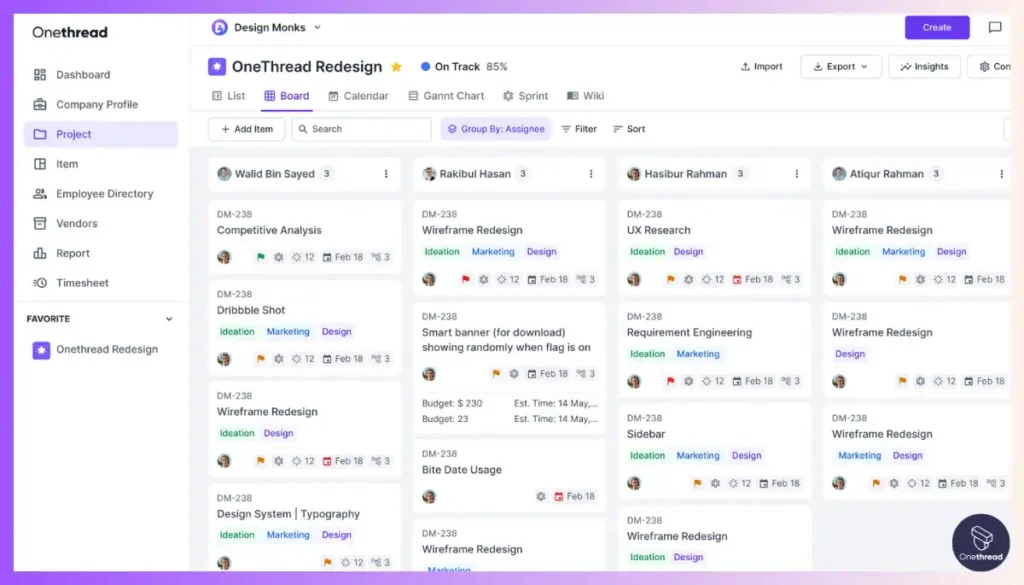

Understand every facet of your campaign, from the big picture to the minute details, ensuring you’re always in control.
Customized Dashboards:
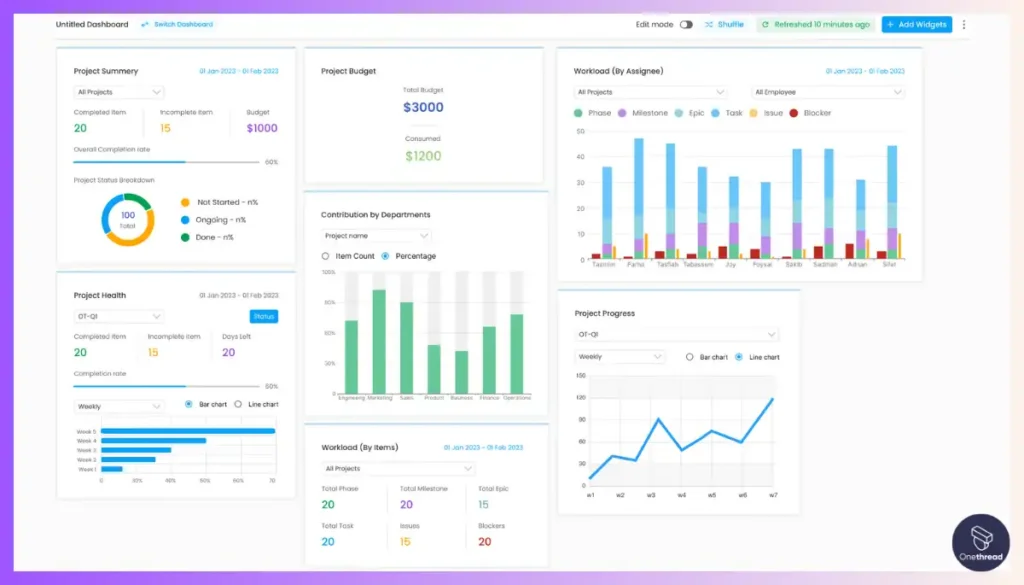

Create dashboards that cater specifically to millennial marketing campaigns, offering insights and data that can drive decision-making.
Graphs and Tables:
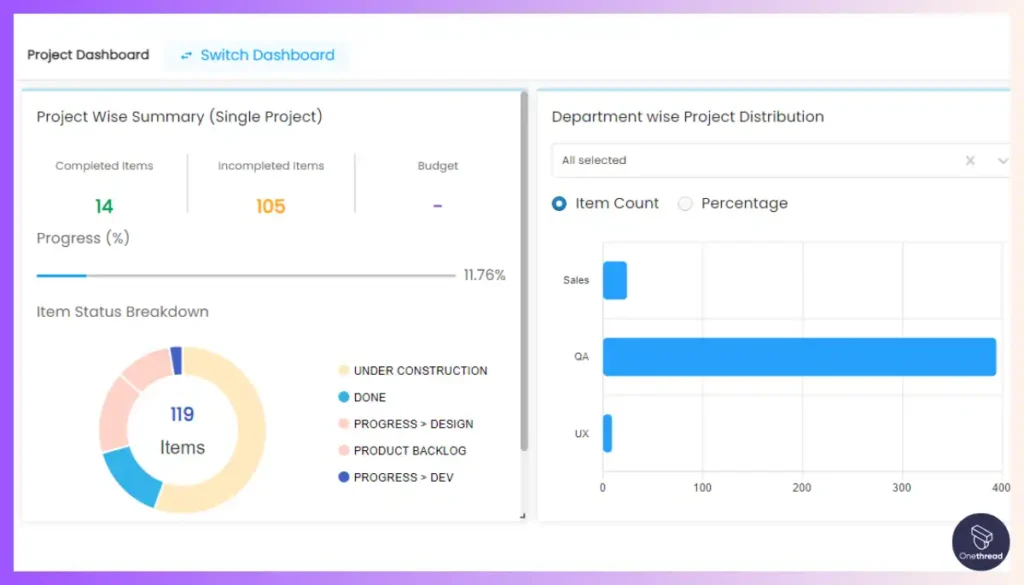

Dive deep into the nuances of your campaign, ensuring you always have a pulse on its progress and effectiveness.
Overall, from planning to execution, Onethread ensures every step is clear, organized, and effective. Whether you’re looking to initiate a campaign, design and visualize its trajectory, or ensure team-wide alignment, Onethread is the tool to trust.
Millennial Marketing Strategy at A Glance
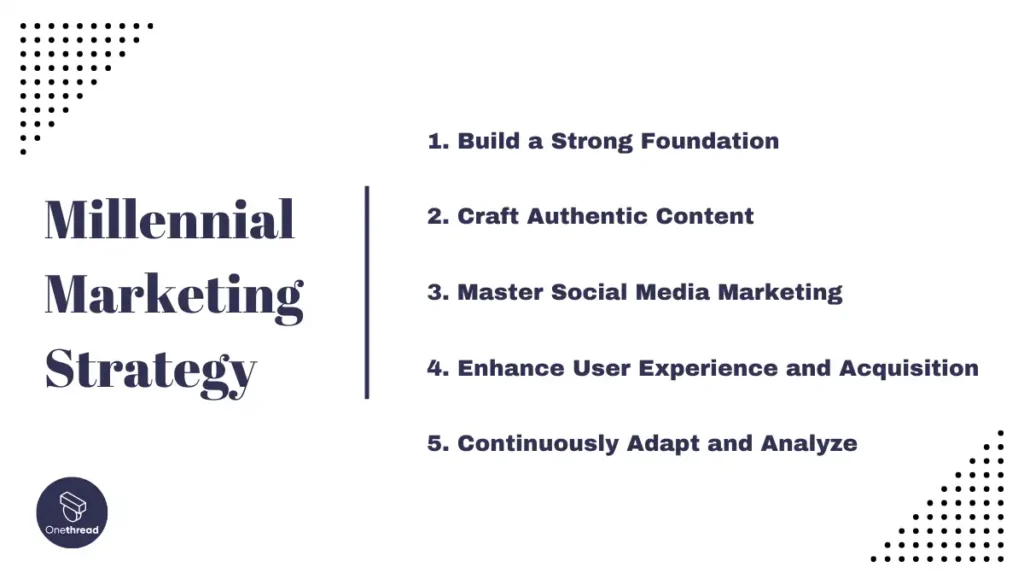

Build a Strong Foundation:
- Define Your Brand Values: Identify your core values and ensure they resonate with Millennial priorities like authenticity, sustainability, and social impact.
- Conduct Market Research: Understand your target Millennial audience. Analyze demographics, interests, media consumption habits, and preferred platforms.
- Optimize for Mobile: Ensure your website, app, and marketing materials are mobile-friendly and offer a seamless user experience.
Craft Authentic Content:
- Develop a Content Strategy: Create a mix of informative, engaging, and valuable content aligned with your brand values and target audience interests.
- Embrace User-Generated Content: Encourage and leverage user-generated content, testimonials, and reviews to build trust and authenticity.
- Incorporate Visuals: Utilize high-quality visuals, infographics, and videos to capture attention and enhance engagement.
- Make it Interactive: Explore interactive formats like quizzes, polls, contests, and live Q&A sessions to boost engagement and participation.
Master Social Media Marketing:
- Establish a Strong Social Media Presence: Actively engage on platforms relevant to your target audience (e.g., Instagram, TikTok, YouTube).
- Connect Organically: Build genuine relationships with your audience through authentic conversations, responding to comments, and running targeted campaigns.
- Leverage Influencer Marketing: Partner with relevant micro-influencers who align with your brand values and resonate with your target audience.
- Showcase Social Impact: Highlight your commitment to social causes and initiatives that resonate with Millennial values.
Enhance User Experience and Acquisition:
- Prioritize Convenience: Offer simple payment options, fast shipping, and subscription services to cater to Millennial preferences.
- Personalize the Experience: Tailor your marketing messages, product recommendations, and customer service to individual needs and preferences.
- Leverage Messaging Apps: Explore marketing opportunities on platforms like WhatsApp or Telegram where Millennials actively engage.
- Utilize QR Code Marketing: Integrate QR codes into your marketing materials for quick access to product information, promotions, or exclusive content.
Continuously Adapt and Analyze:
- Measure and Track Results: Monitor the performance of your marketing campaigns and analyze data to identify what works and what needs improvement.
- Stay Agile and Adaptive: Be prepared to pivot your strategies based on changing trends, audience preferences, and competitor activity.
- Maintain Transparency and Authenticity: Communicate openly with your audience, acknowledge feedback, and address concerns with honesty and integrity.
Frequently Asked Questions
How do you target millennials in advertising?
Targeting millennials in advertising requires understanding their behaviors like heavy social and mobile usage alongside values like diversity and sustainability. Capturing their 8-second attention span depends on concise, engaging messaging on preferred platforms. Optimizing for devices rather than TV/radio ads is essential. Emphasize corporate responsibility and ethical sourcing to align with this socially conscious generation.
Why don’t millennials respond to ads?
Millennials don’t respond to traditional ads because of banner blindness developed amid information overload. Having grown up saturated by promotions yet lacking funds to spend, they distrust old-school tactics like inflated claims or hard sells. Persuasive language actually decreases trust for this skeptical cohort expecting authenticity. Just 1% find typical ads enhance brand affinity compared to 84% valuing organic peer reviews.
How to get Millennials to trust and respond to your advertising?
Gaining millennials’ advertising trust and response requires value-driven messaging tailored to their interests on preferred social platforms. For example, brands like Urban Outfitters resonate through campaigns aligning to identities, like enabling self-expression. Sharing user-generated content fosters 86% more engagement as they assign 33% more memorability to real consumer perspectives versus promotional ads.
How do I advertise to Gen Z and Millennials?
Advertise through concise, eye-catching social content focused on convenience and cause-alignment for Gen Z and millennials. Ensure authentic transparency around sustainable practices that 50% say must reflect their principles. Collaborate with diverse influencers already trusted voices. Prioritizing mobile with bite-sized video and leveraging platforms matching their digital behaviors works better than generalized traditional tactics.
What Are Some Common Misconceptions About Millennials That Could Impact Marketing Strategies?
Well, there are quite a few. Understanding the misconceptions and adjusting marketing strategies accordingly can help businesses more effectively target and engage with the millennial demographic. Let’s hear them out.
- Tech-obsessed: Not all Millennials are solely reliant on technology.
- Brand Disloyalty: They value authenticity and can be brand loyal.
- Always Cash-strapped: Many are in their peak earning years and willing to spend.
- Online-only Shoppers: Many still appreciate in-store experiences.
- Impulsive Buyers: They often research and compare before buying.
- One-size-fits-all: They have diverse interests and backgrounds.
- Ignore Traditional Media: They still engage with TV, radio, and print.
- Unaffected by Ads: Prefer authentic content over traditional advertisements.
How Does The Geographic Location Of Millennials Impact Their Preferences For Marketing?
Your geographic location can affect your preferences for marketing. For example, urban Millennials tend to prefer experiences and convenience, while rural Millennials may prioritize affordability and quality.
Are There Any Specific Industries Or Products That Millennials Are Particularly Interested In?
As a millennial, you may be interested in industries and products that align with your values such as sustainability, tech innovation, and health and wellness. However, individual preferences vary greatly within this generation.
What Role Does Personalized Marketing Play In Targeting Millennials?
Personalized marketing is crucial when targeting Millennials. They want to feel understood and valued as individuals, not just a demographic. Use data and technology to create tailored experiences that resonate with their unique interests and lifestyles.
How Can Businesses Measure The Effectiveness Of Their Millennial Marketing Campaigns?
To measure the effectiveness of your millennial marketing campaigns, track metrics like social media engagement, website traffic, and sales. Use customer feedback and surveys to gain insights and adjust your strategy accordingly.
Conclusion
So, now that you know all about marketing to millennials, it’s time to put that knowledge into action. Remember, this generation values authenticity, personalization, and social responsibility. They want brands that align with their values and make a difference in the world.
To successfully market to millennials, focus on creating engaging content that resonates with them, utilizing social media platforms like Instagram and TikTok, and using data-driven strategies to target your audience effectively.
And don’t forget to track your progress along the way – Onethread can help you plan and execute successful millennial marketing campaigns while keeping everything organized in one place. With these tips and tools in hand, you’ll be well on your way to reaching the largest consumer group in history.
